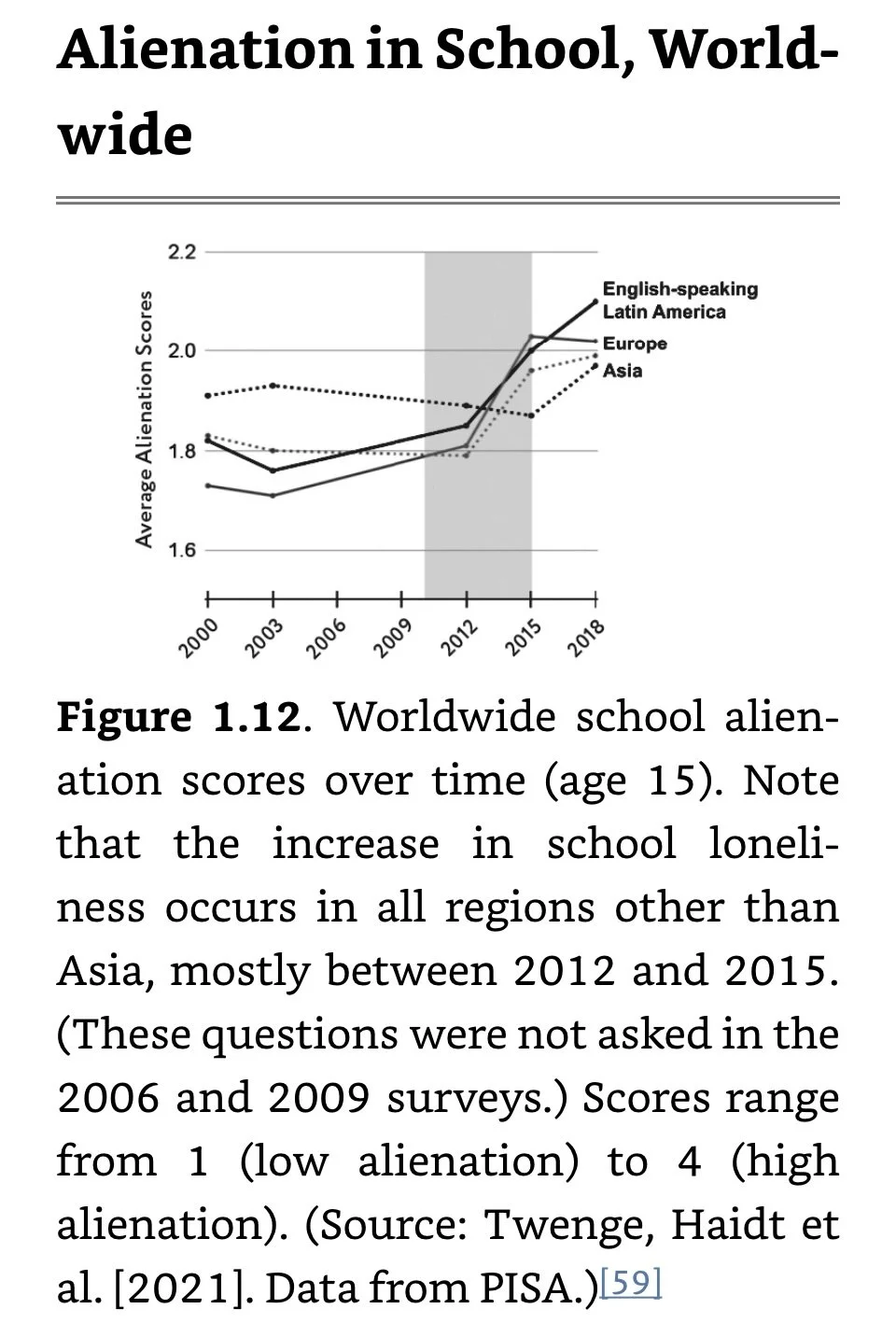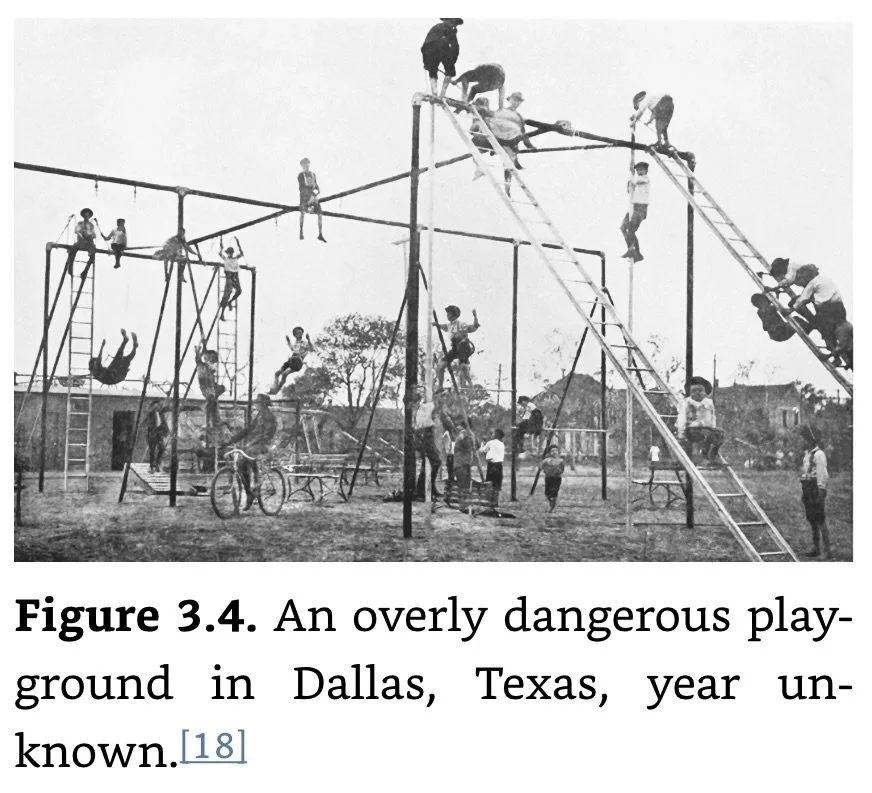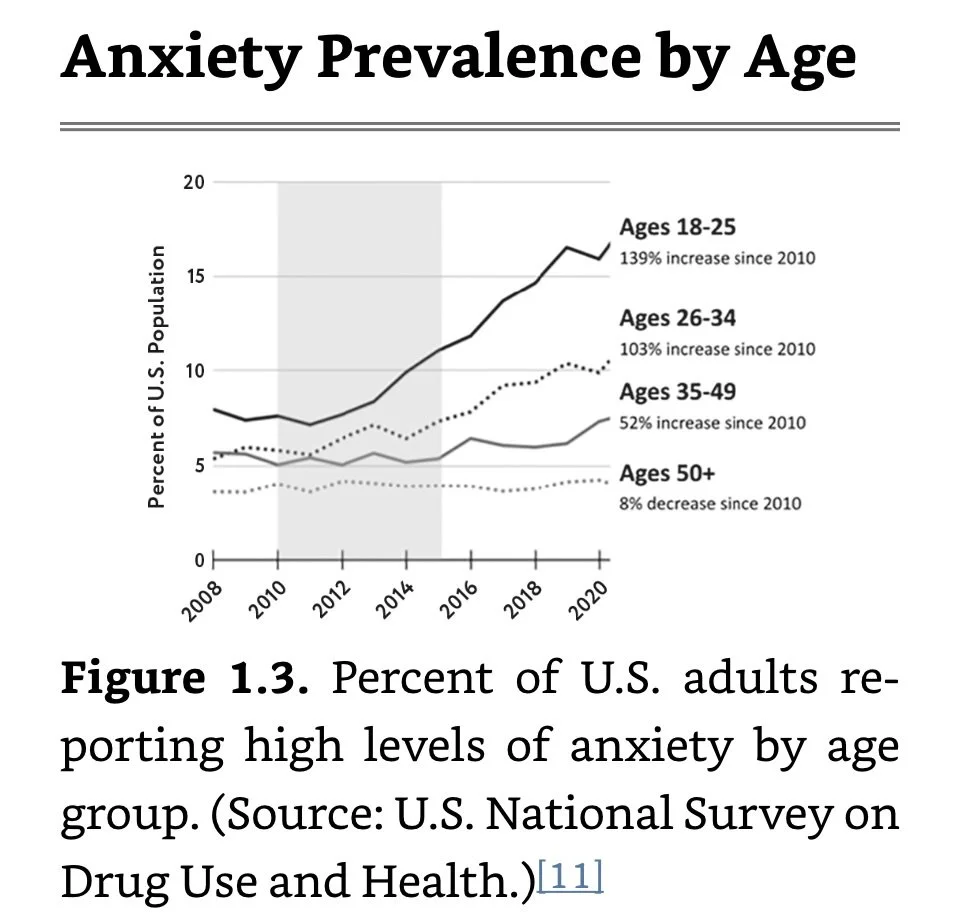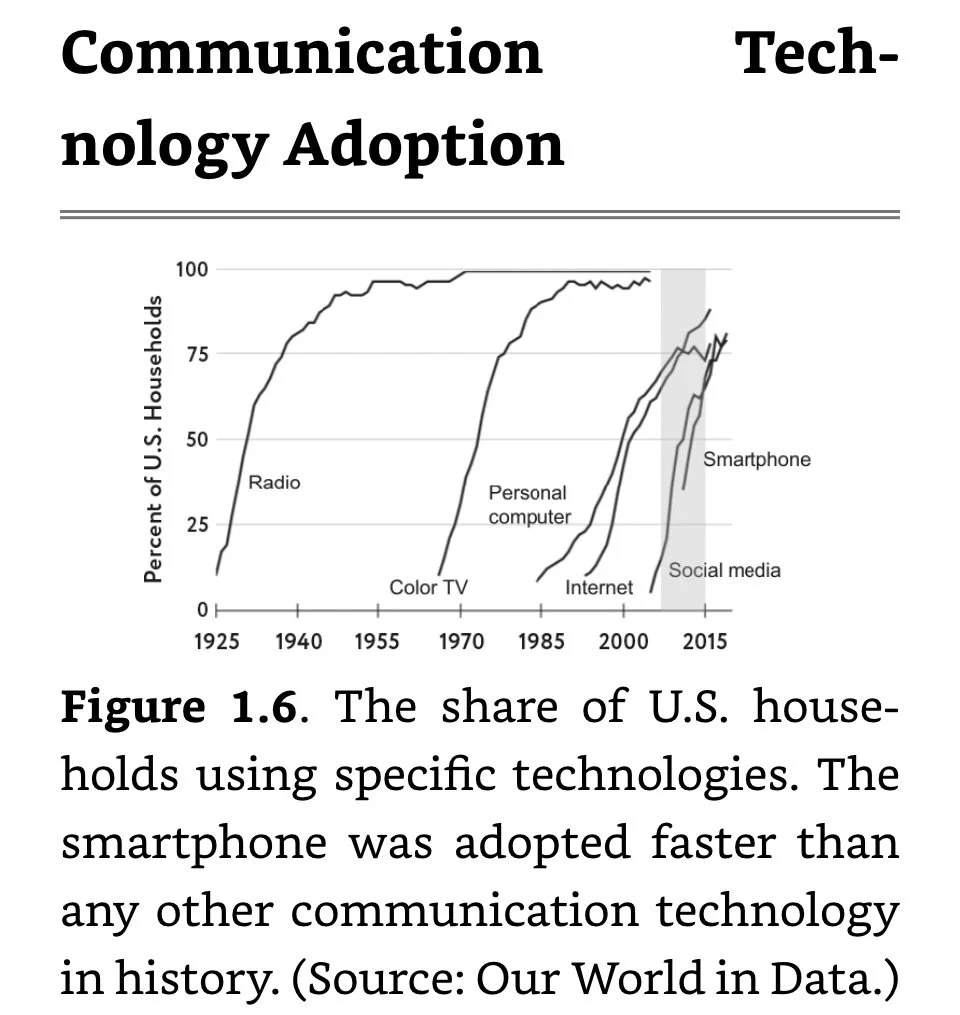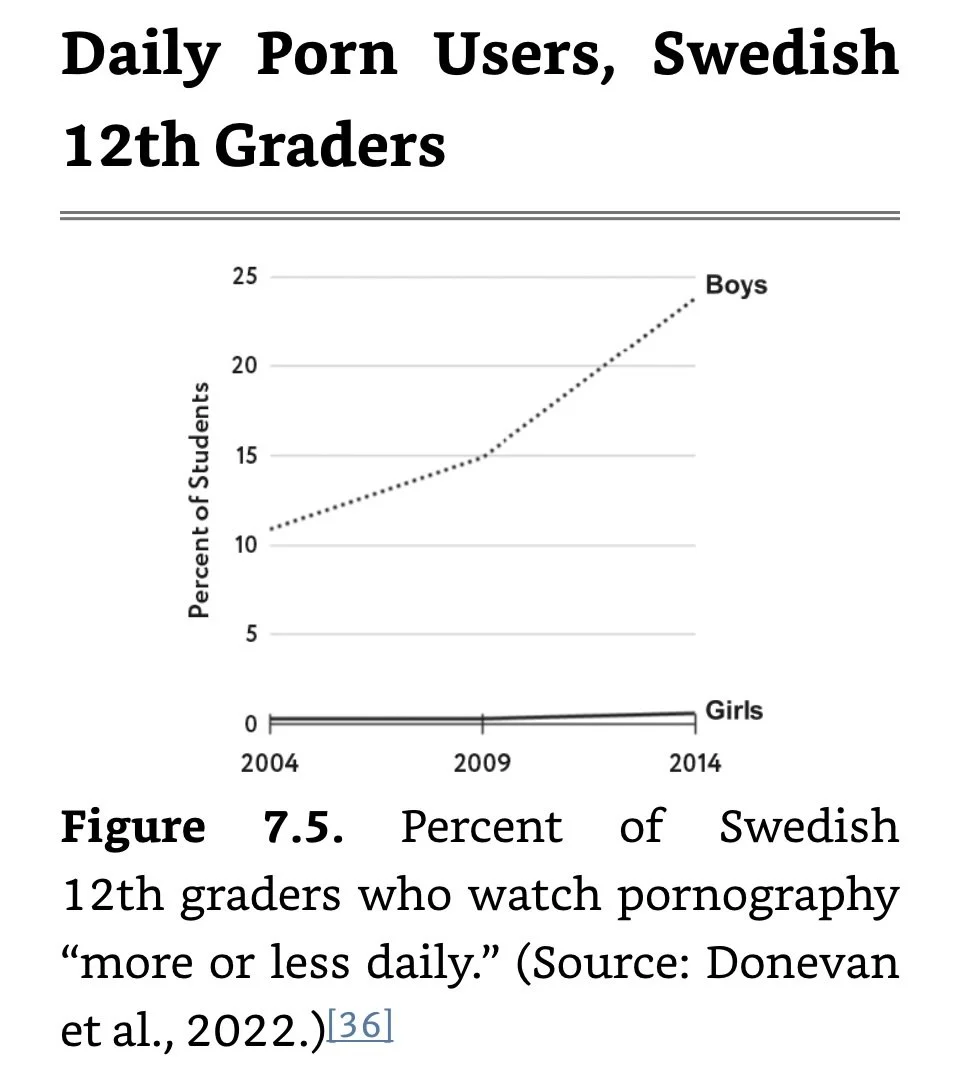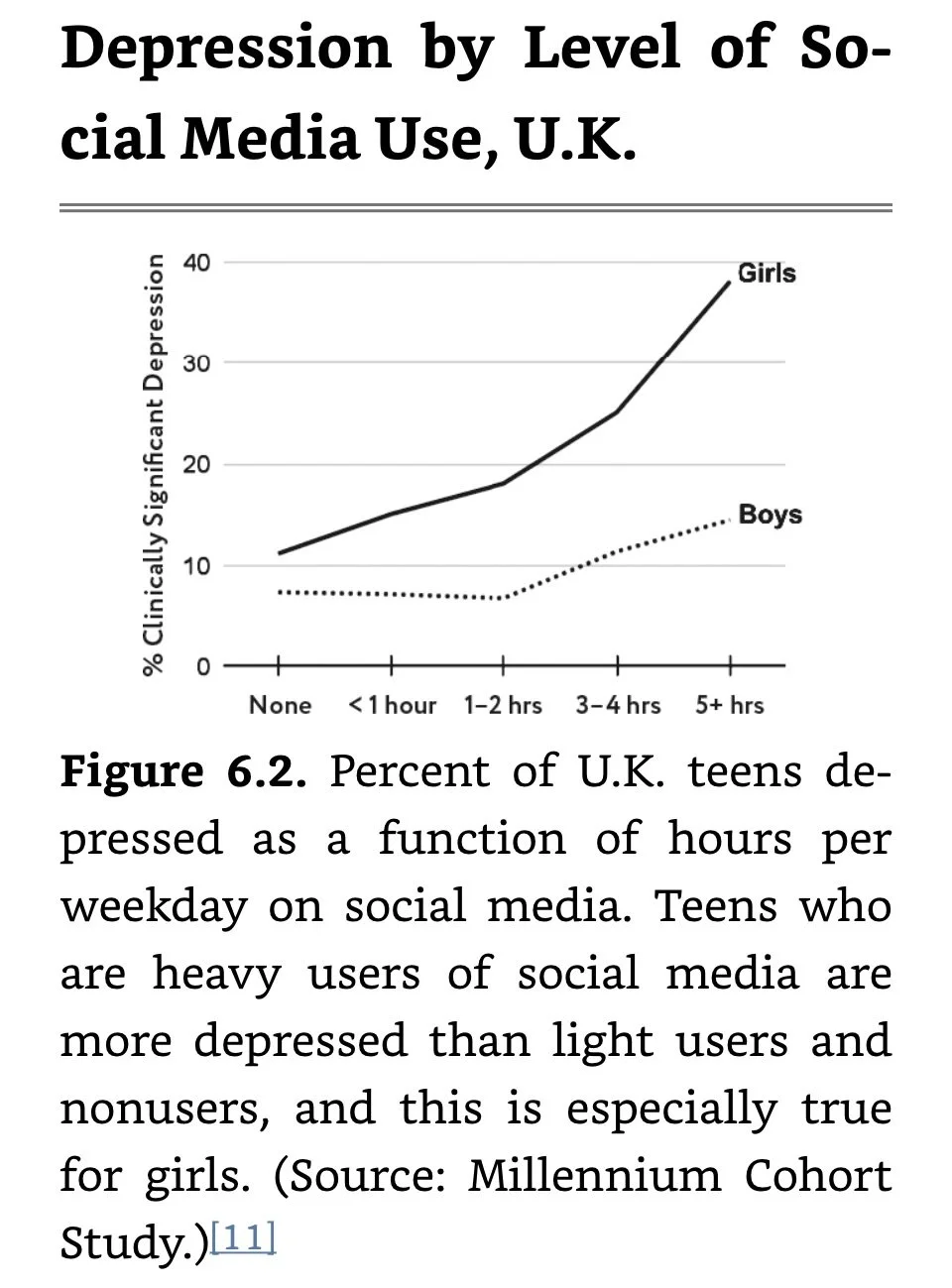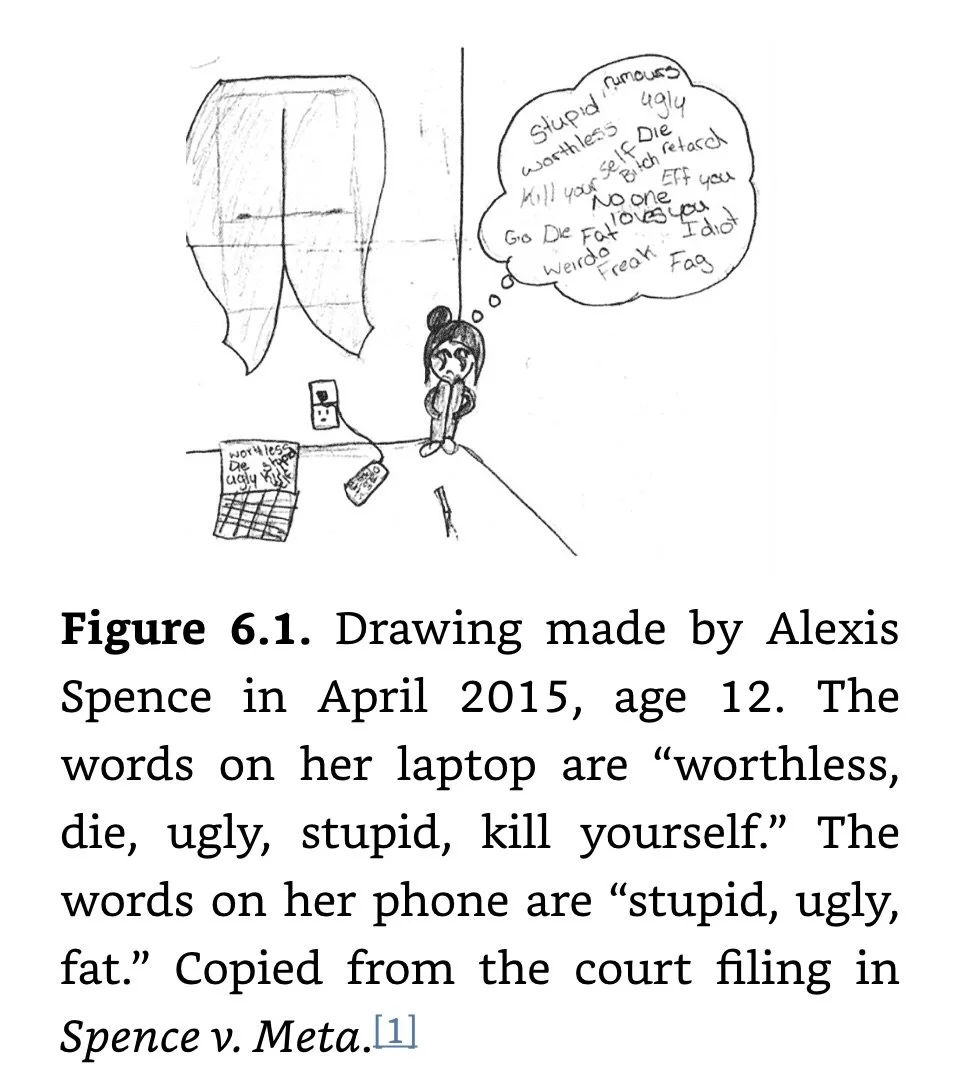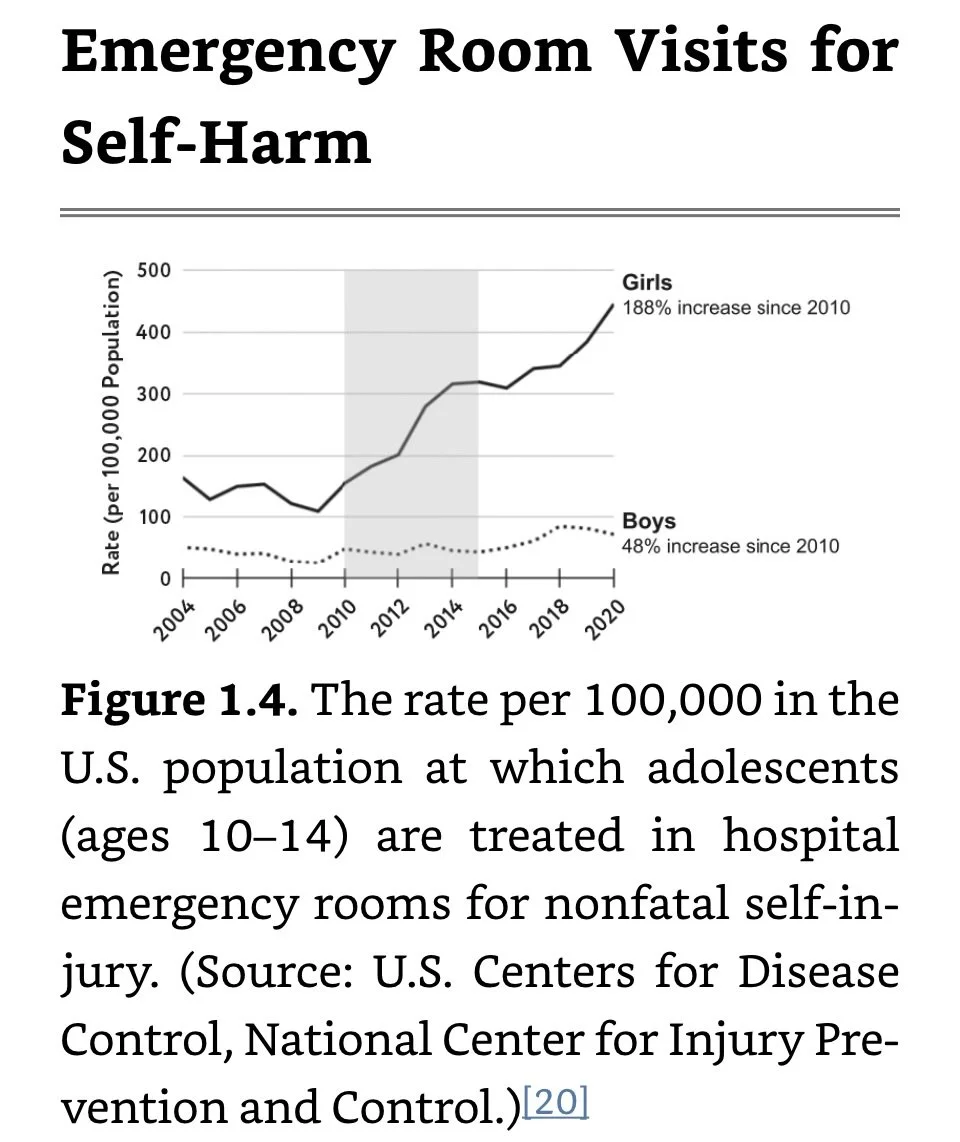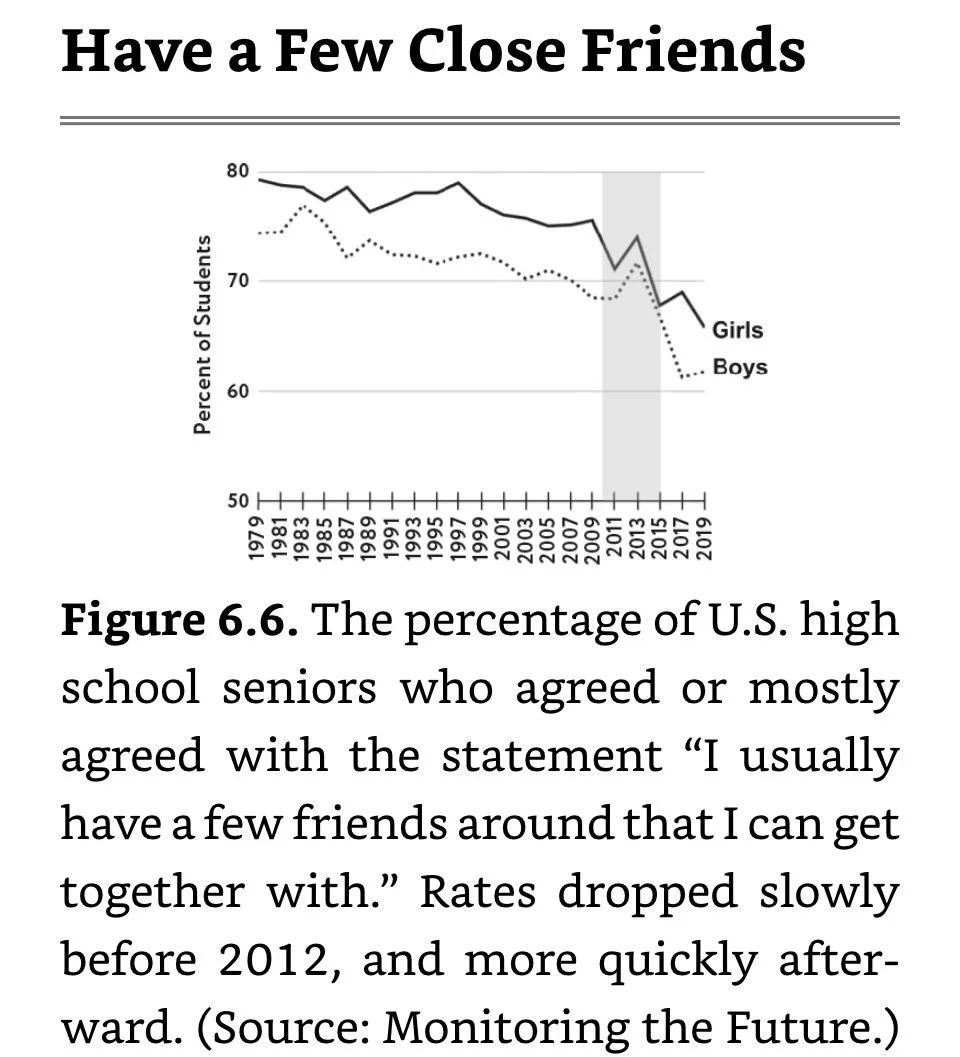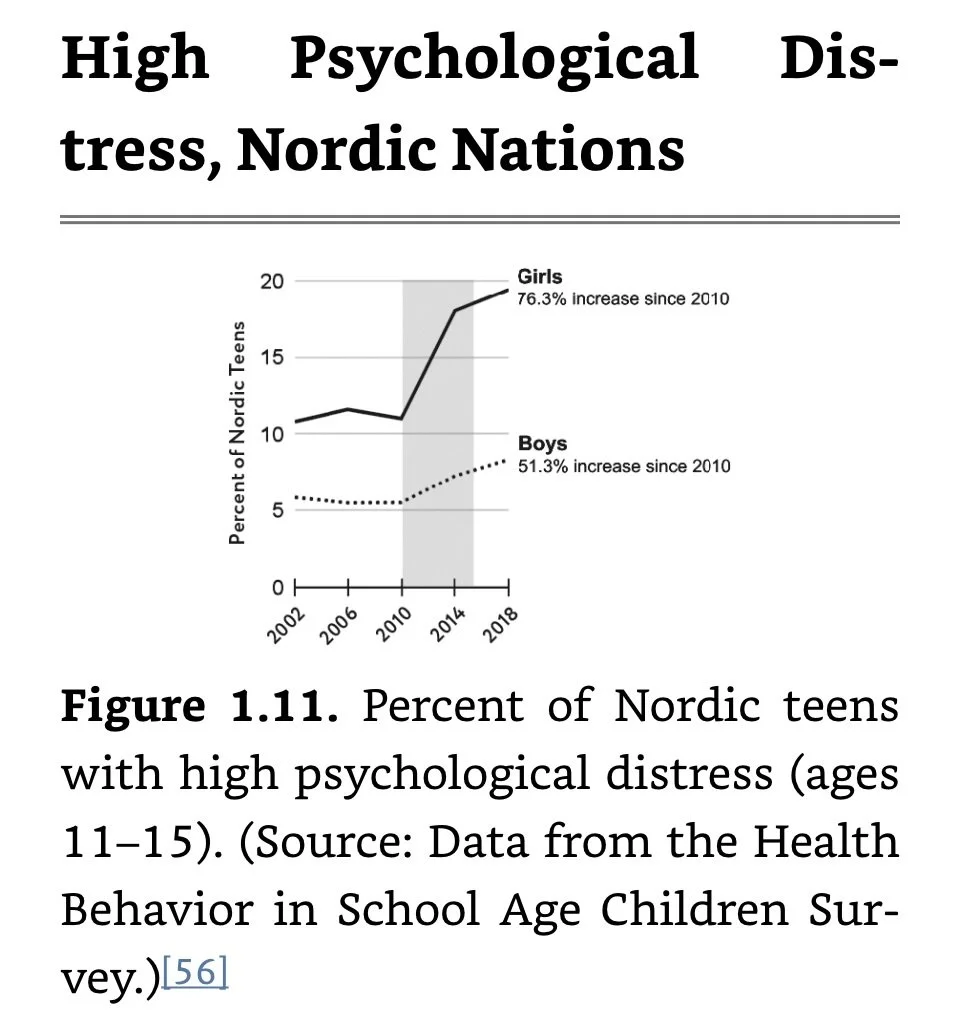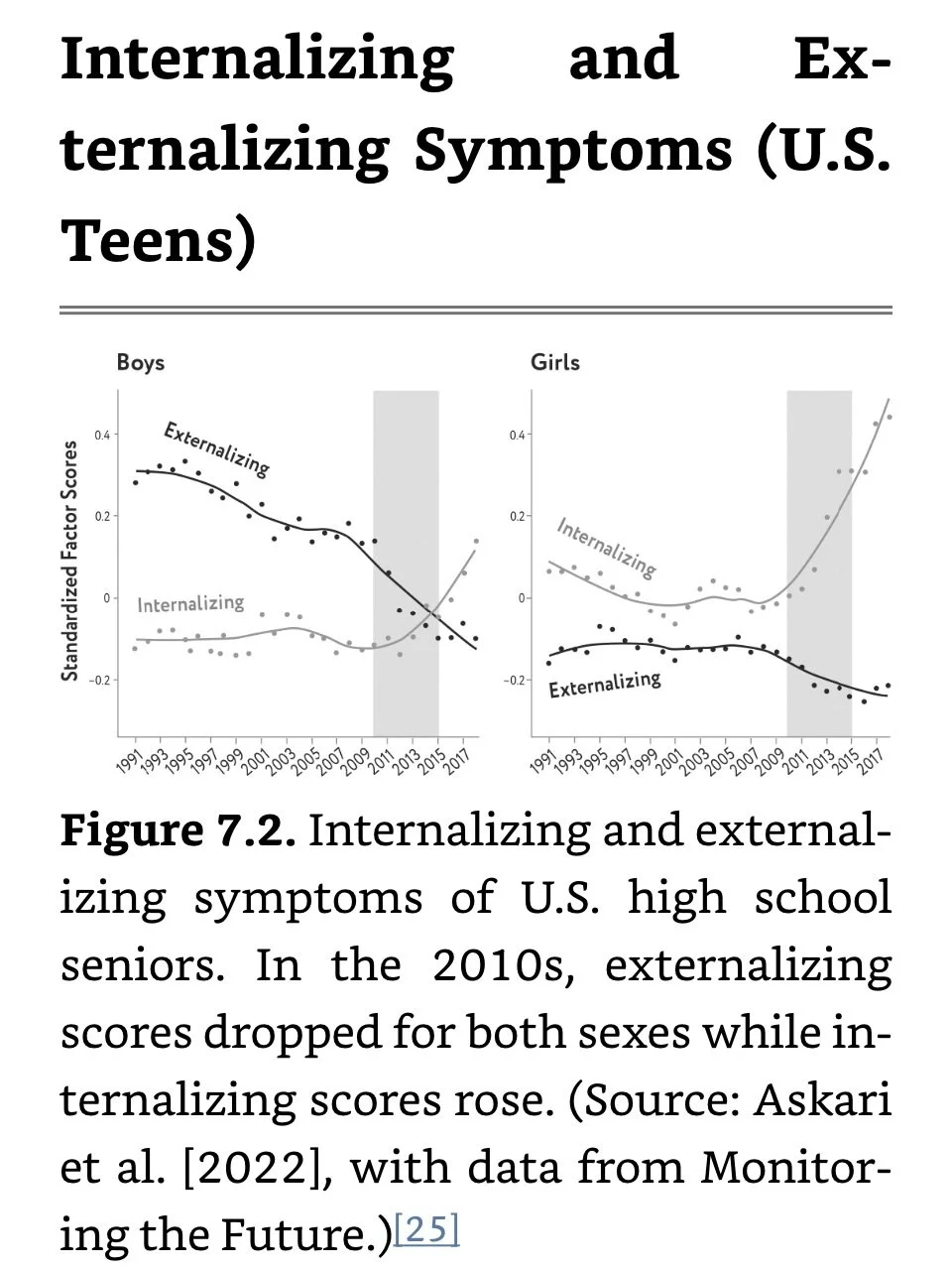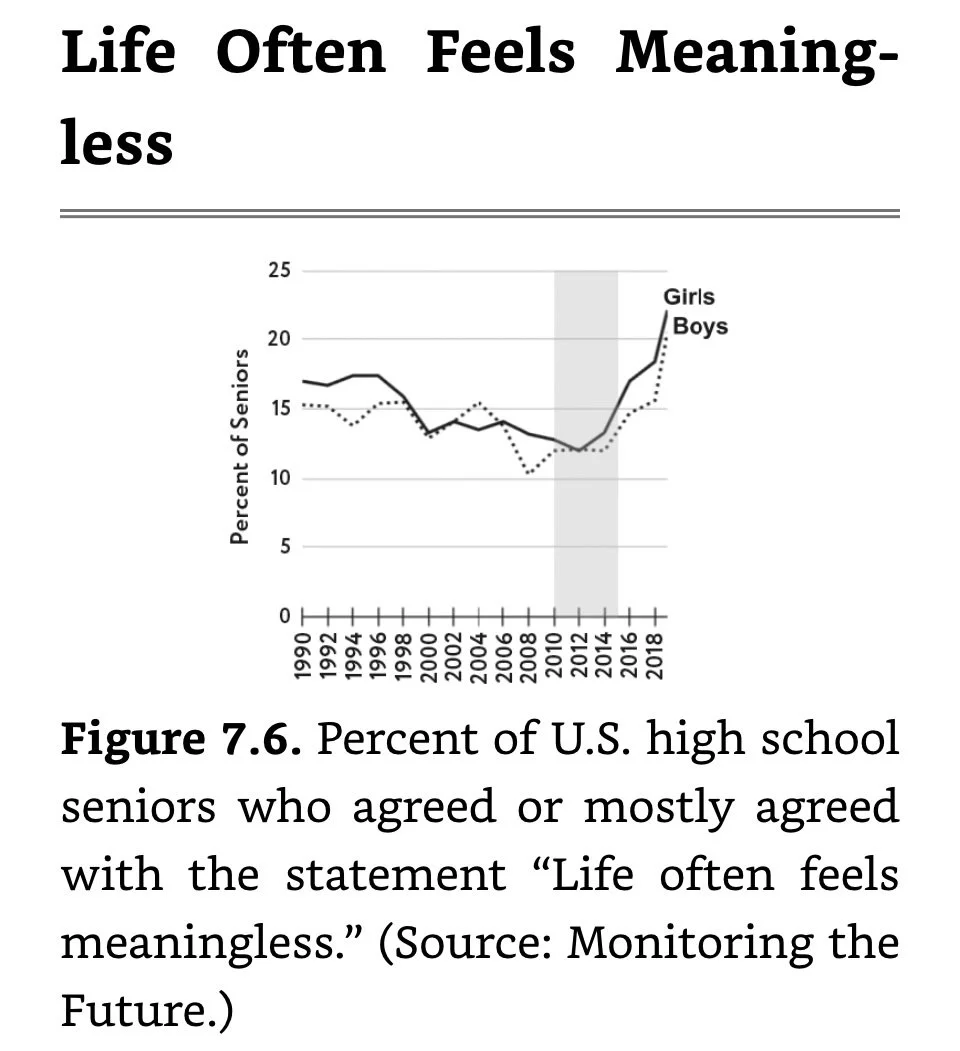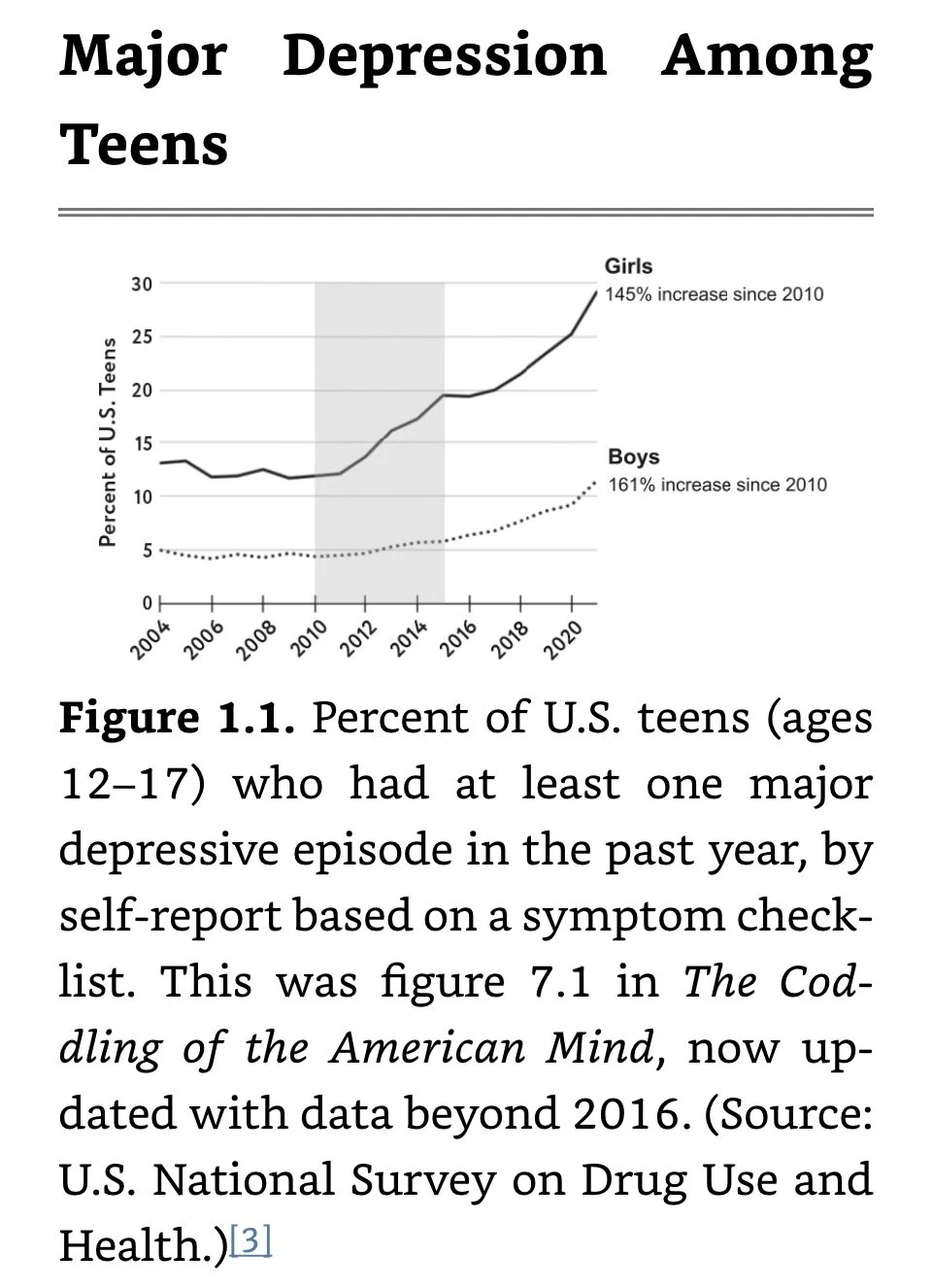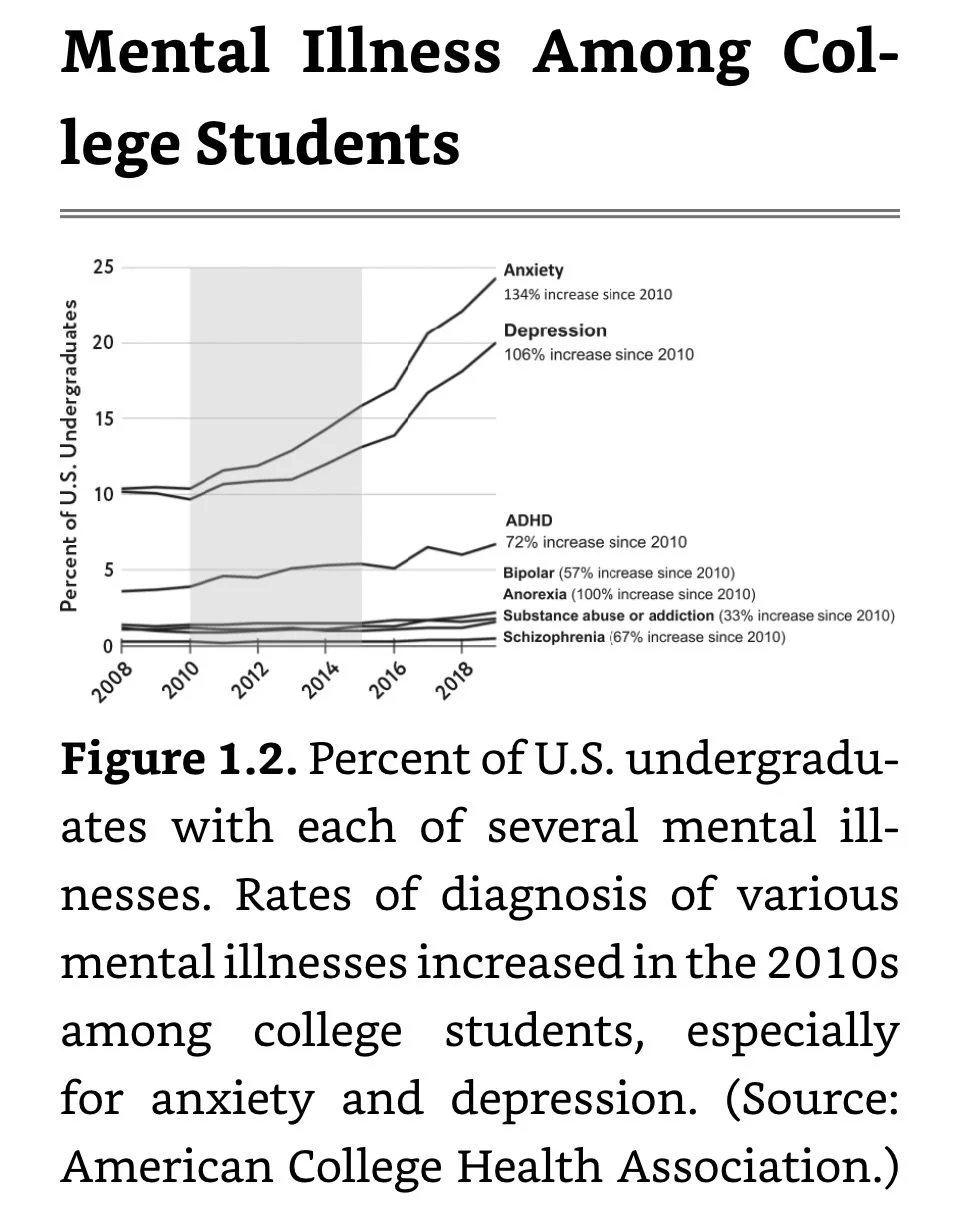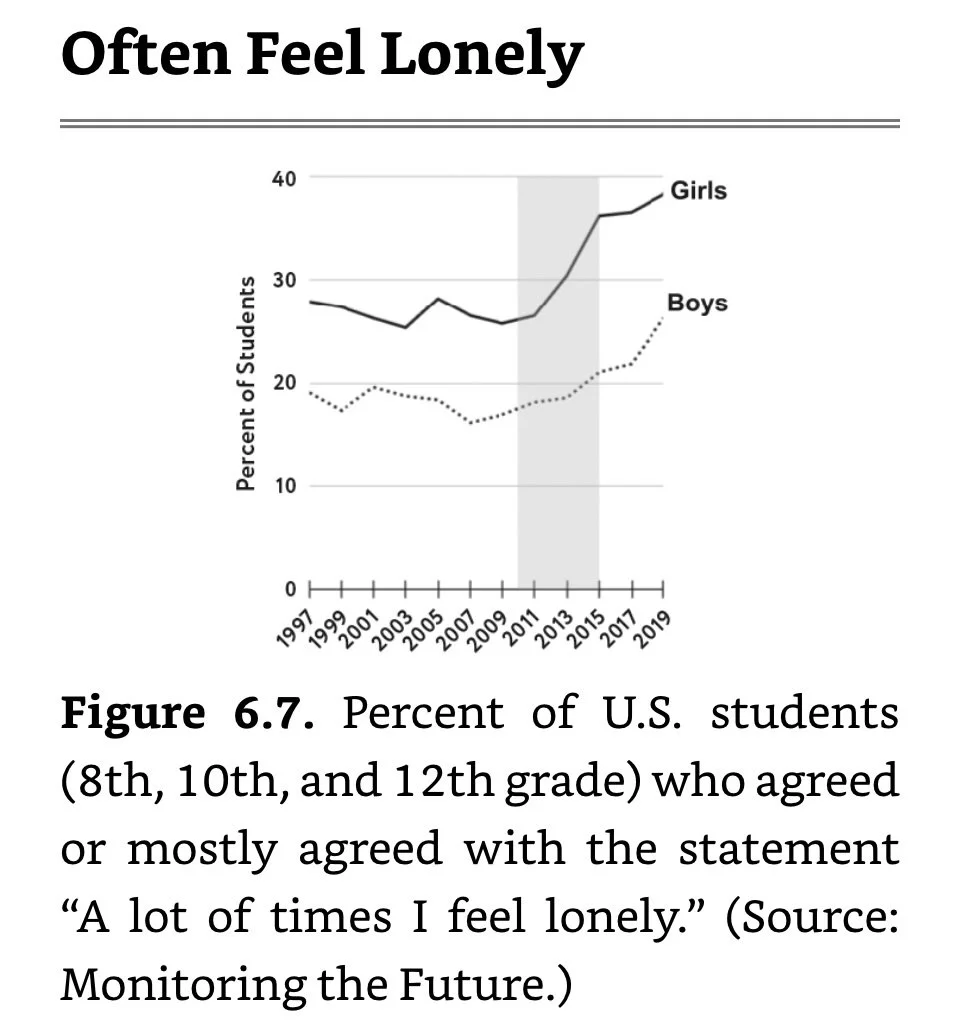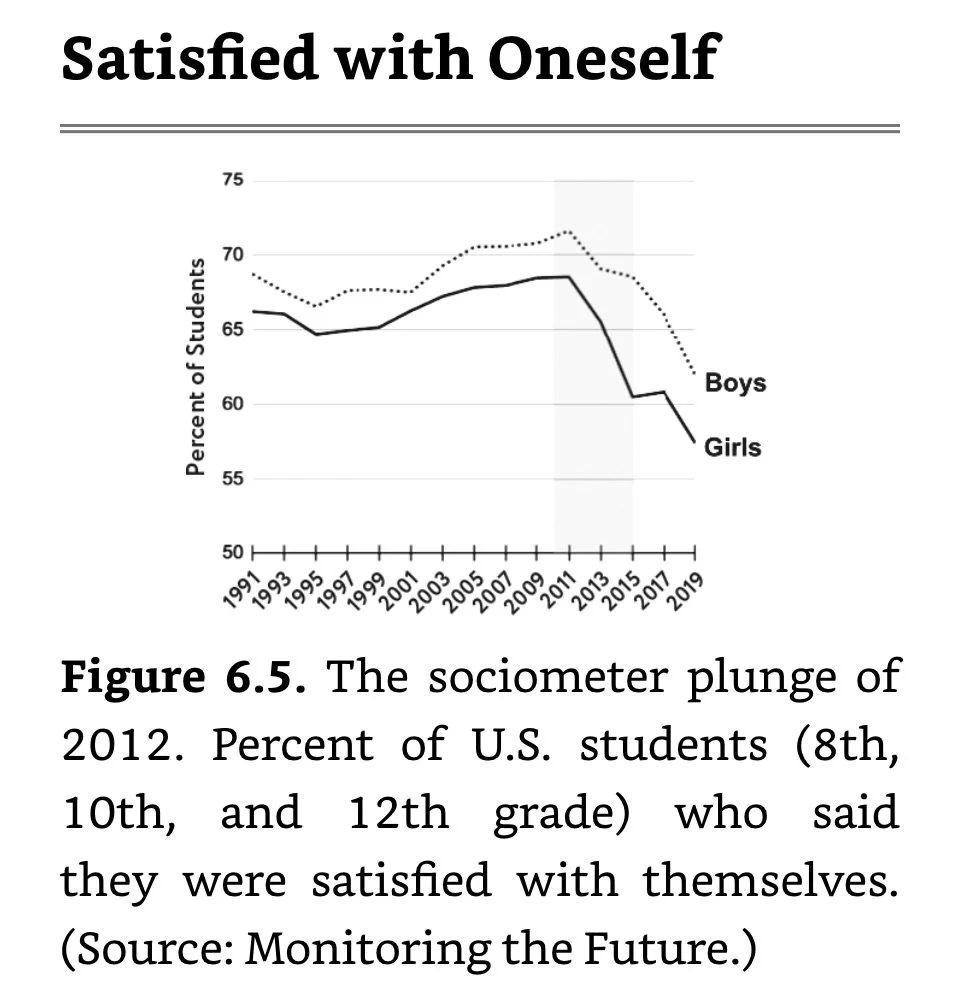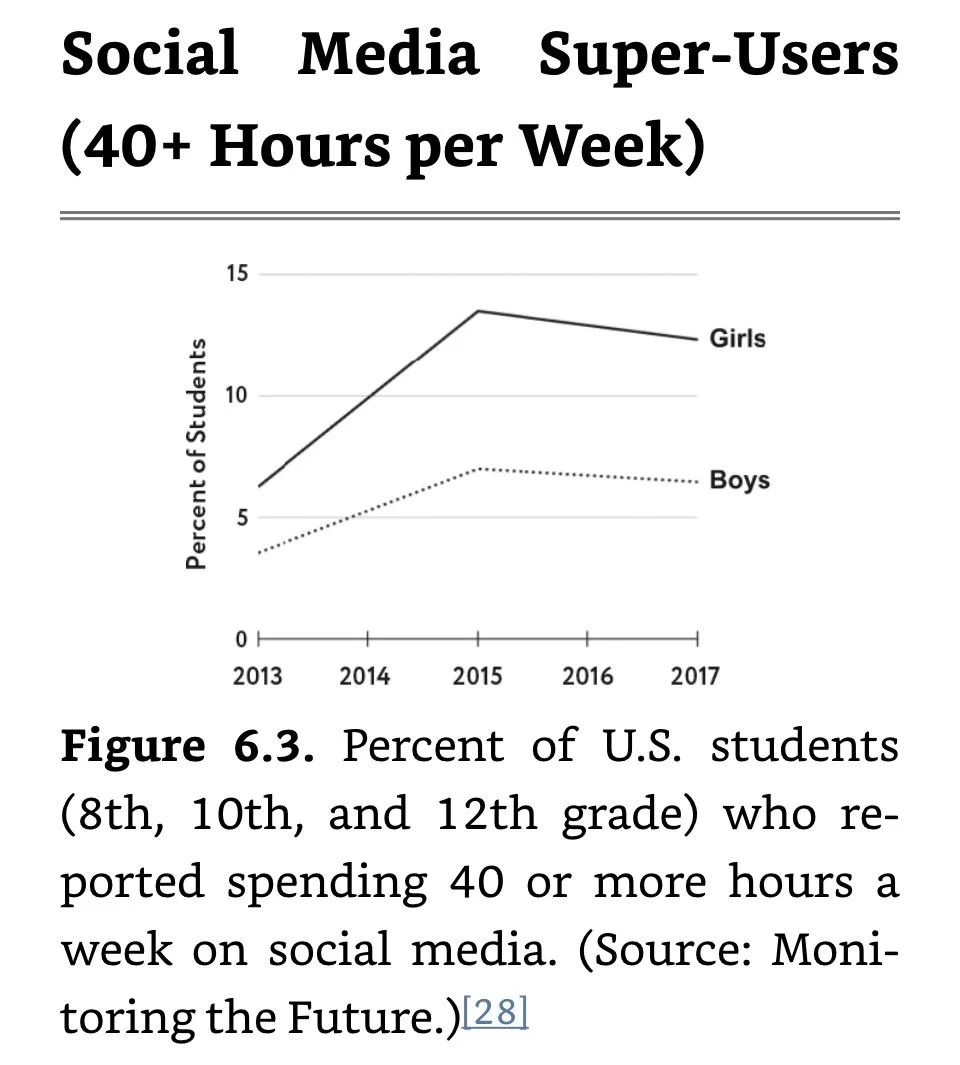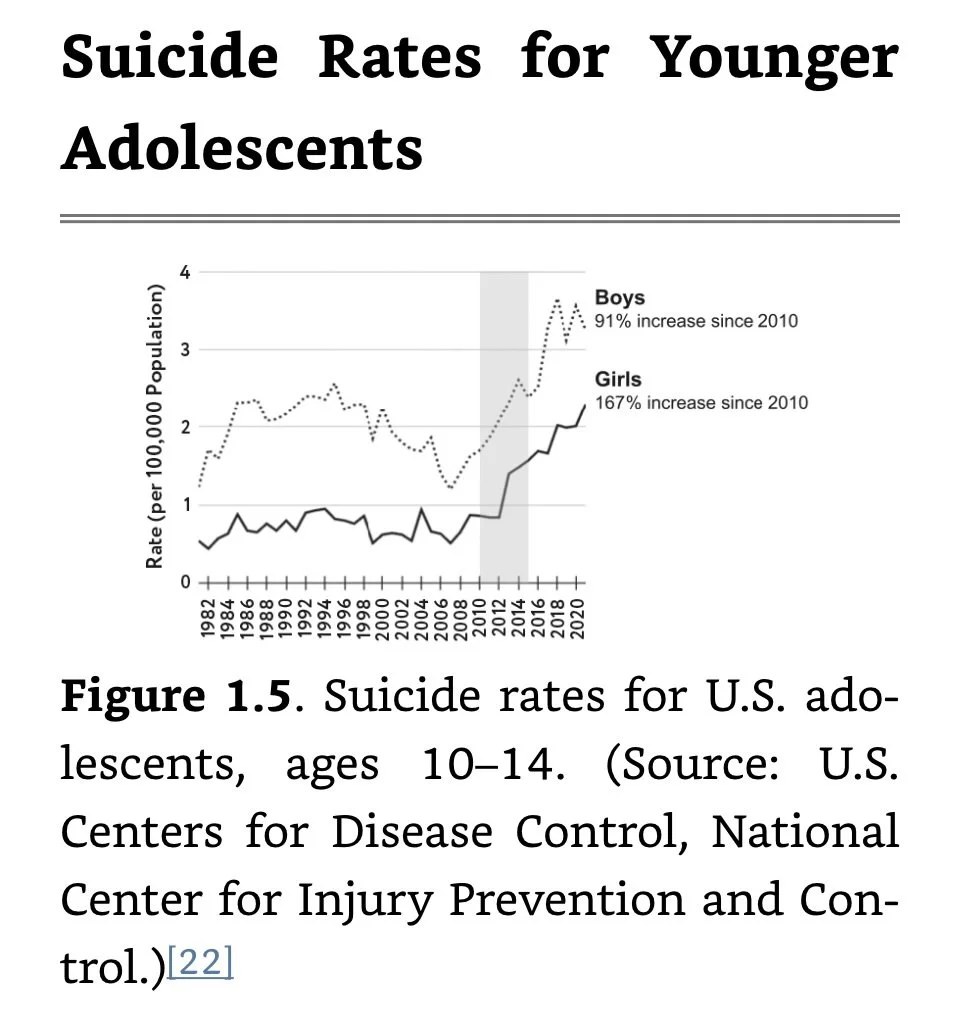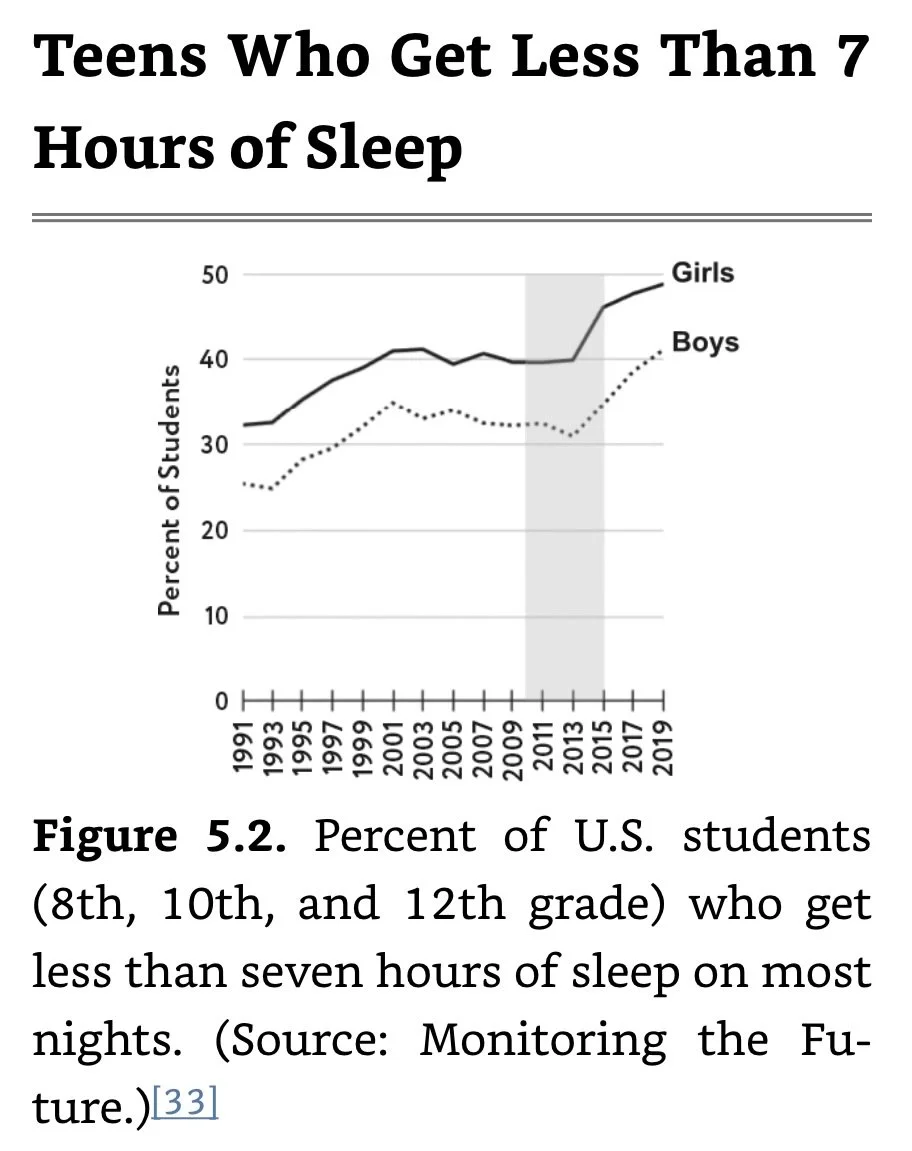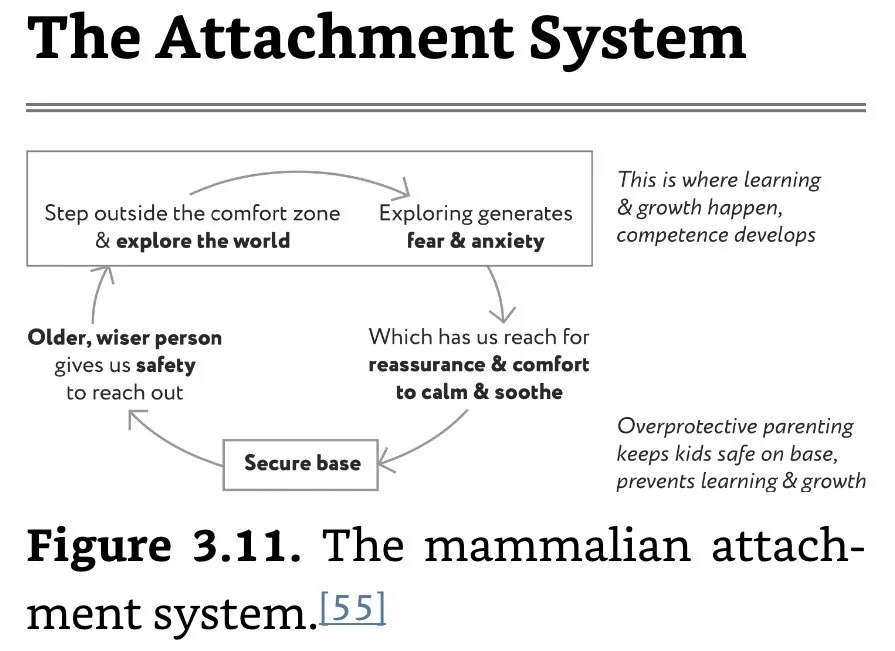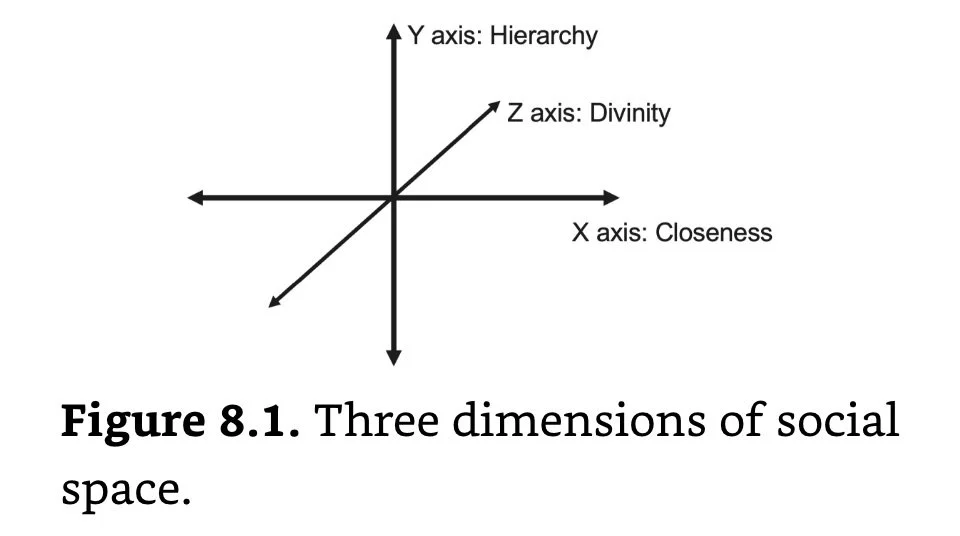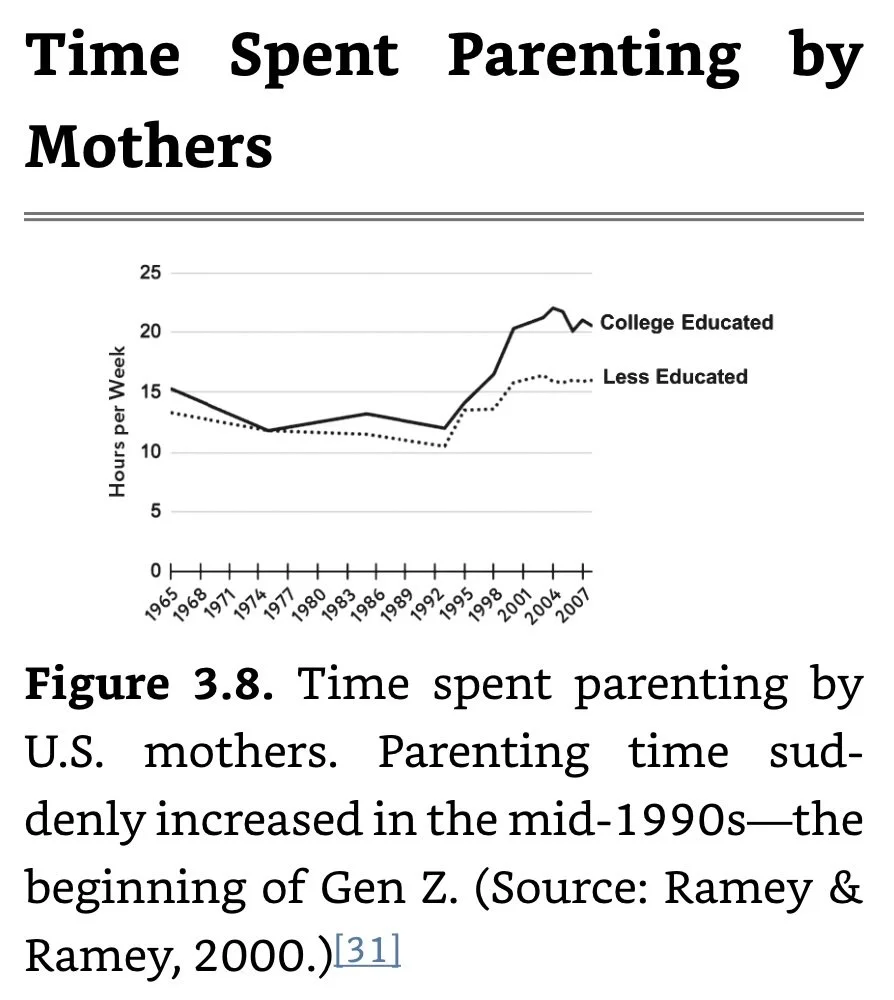The Anxious Generation by Haidt
Ref: Jonathan Haidt (2024). The Anxious Generation. Penguin Publishing.
https://www.AnxiousGeneration.com
___________________________________________________________________________
Summary
My focus (in this book) is on why rates of mental illness went up in so many countries between 2010 and 2015, a period I call “The Great Rewiring” for Gen Z (and some late millennials) while older generations were far less affected. In “the Great Rewiring,” social patterns, role models, emotions, physical activity, and even sleep patterns were fundamentally recast, for adolescents, over the course of just five years.
The only plausible theory I have found that can explain the international decline in teen mental health is the sudden and massive change in the technology that teens were using to connect with each other…Boys gravitated to watching YouTube videos, to using text-based platforms such as Reddit, and especially to playing online multiplayer video games. Girls became much heavier users of the new visually oriented platforms, primarily Instagram, followed by Snapchat, Pinterest, and Tumblr.
By the early 2010s, social “networking” systems that had been structured (for the most part) to connect people turned into social media “platforms” redesigned (for the most part) in such a way that they encouraged one-to-many public performances in search of validation, not just from friends but from strangers.
Well-intentioned parents who try to raise their children in a bubble of satisfaction, protected from frustration, consequences, and negative emotions, may be harming their children. They may be blocking the development of competence, self-control, frustration tolerance, and emotional self-management. Several studies find that such “coddling” or “helicopter parenting” is correlated with later anxiety disorders, low self-efficacy (which is the inner confidence that one can do what is needed to reach one’s goals), and difficulty adjusting to college.
Antifragile: Things that gain from disorder (coined by NYU Nassim Taleb in his 2012 book, Antifragile); the word “antifragile” is used to describe things that need to get knocked over now and then in order to become strong.
Critical Periods: Windows of time in which a young animal must learn something, or it will be hard if not impossible to learn later.
Safetyism: A culture or belief system in which safety has become a sacred value, which means that people become unwilling to make trade-offs demanded by other practical and moral concerns. ‘Safety’ trumps everything else, no matter how unlikely or trivial the potential danger.”
This book tells the story of what happened to the generation born after 1995, popularly known as Gen Z…The oldest members of Gen Z began puberty around 2009, when several tech trends converged: the rapid spread of high-speed broadband in the 2000s, the arrival of the iPhone in 2007, and the new age of hyper-viralized social media. The last of these was kicked off in 2009 by the arrival of the “like” and “retweet” (or “share”) buttons, which transformed the social dynamics of the online world…Another trend began just a few years later, and it hit girls much harder than boys: the increased prevalence of posting images of oneself, after smartphones added front-facing cameras (2010) and Facebook acquired Instagram (2012), boosting its popularity.
My central claim in this book is that these two trends—overprotection in the real world and underprotection in the virtual world—are the major reasons why children born after 1995 became the anxious generation.
This book has four parts. THEY explain the mental health trends among adolescents since 2010 (part 1); the nature of childhood and how we messed it up (part 2); the harms that result from the new phone-based childhood (part 3); and what we must do now to reverse the damage in our families, schools, and societies (part 4).
___________________________________________________________________________
Intro
Social media companies inflicted their greatest damage on girls, and video game companies and pornography sites, sank their hooks deepest into boys. By designing a firehose of addictive content that entered through kids’ eyes and ears, and by displacing physical play and in-person socializing, these companies have rewired childhood and changed human development on an almost unimaginable scale.
While the reward-seeking parts of the brain mature earlier, the frontal cortex—essential for self-control, delay of gratification, and resistance to temptation—is not up to full capacity until the mid-20s, and preteens are at a particularly vulnerable point in development. As they begin puberty, they are often socially insecure, easily swayed by peer pressure, and easily lured by any activity that seems to offer social validation.
Gen Z became the first generation in history to go through puberty with a portal in their pockets that called them away from the people nearby and into an alternative universe that was exciting, addictive, unstable, and—as I will show—unsuitable for children and adolescents.
The Happiness Hypothesis, examines 10 “great truths” that ancient cultures East and West discovered about how to live a flourishing life. My second book, The Righteous Mind, lays out my own research on the evolved psychological foundations of morality. I explore the reasons why good people are divided by politics and religion, paying special attention to people’s needs to be bound into moral communities that give them a sense of shared meaning and purpose.
Four Foundational Reforms that would provide a foundation for healthier childhood in the digital age:
No smartphones before high school. Parents should delay children’s entry into round-the-clock internet access by giving only basic phones (phones with limited apps and no internet browser) before 9th grade (~ age 14).
No social media before 16. Let kids get through the most vulnerable period of brain development before connecting them to a firehose of social comparison and algorithmically chosen influencers.
Phone-free schools. In all schools from elementary through high school, students should store their phones, smartwatches, and any other personal devices that can send or receive texts in phone lockers or locked pouches during the school day. That is the only way to free up their attention for each other and for their teachers.
Far more unsupervised play and childhood independence. That’s the way children naturally develop social skills, overcome anxiety, and become self-governing young adults.
___________________________________________________________________________
---Part 1 A Tidal Wave
___________________________________________________________________________
Ch 1 The Surge of Suffering
The increases in mental illnesses were similar for both sexes—roughly 150%. In other words, depression became roughly two and a half times more prevalent. The increases happened across all races and social classes…The rise is concentrated in disorders related to anxiety and depression, which are classed together in the psychiatric category known as internalizing disorders…Across ages, cultures, and countries, girls and women suffer higher rates of internalizing disorders, while boys and men suffer from higher rates of externalizing disorders.
The paired technologies of social media and the smartphone reached a majority of homes by 2012 or 2013. That is when girls’ mental health began to collapse, and when boys’ mental health changed in a more diffuse set of ways.
Internalizing Disorder: Disorders in which a person feels strong distress and experiences the symptoms inwardly. The person with an internalizing disorder feels emotions such as anxiety, fear, sadness, and hopelessness. They ruminate. They often withdraw from social engagement.
Externalizing Disorder: Disorders in which a person feels distress and turns the symptoms and responses outward, aimed at other people. These conditions include conduct disorder, difficulty with anger management, and tendencies toward violence and excessive risk-taking.
A 2023 study of American college students found that 37% reported feeling anxious “always” or “most of the time,” while an additional 31% felt this way “about half the time.”
Cognitive distortions that are the focus of cognitive behavioral therapy (CBT), such as catastrophizing, overgeneralizing, and black-and-white thinking. For those with anxiety disorders, these distorted thinking patterns often elicit uncomfortable physical symptoms, which then induce feelings of fear and worry, which then trigger more anxious thinking, perpetuating a vicious cycle.
The second most common psychological disorder among young people today is depression…The main psychiatric category here is called major depressive disorder (MDD). Its two key symptoms are depressed mood (feeling sad, empty, hopeless) and a loss of interest or pleasure in most or all activities…For a diagnosis of MDD, these symptoms must be consistently present for at least 2wks. They are often accompanied by physical symptoms, including significant weight loss or weight gain, sleeping far less or far more than normal, and fatigue. They are also accompanied by disordered thinking, including an inability to concentrate, dwelling on one’s transgressions or failings (causing feelings of guilt) and the many cognitive distortions that CBT tries to counteract. People experiencing a depressive disorder are likely to think about suicide because it feels like their current suffering will never end, and death is an end.
People are more likely to become depressed when they become (or feel) more socially disconnected, and depression then makes people less interested and able to seek out social connection. As with anxiety, there is a vicious circle…People don’t get depressed when they face threats collectively; they get depressed when they feel isolated, lonely, or useless.
Nonsuicidal self-injury (NSSI): Self harm, often done by cutting oneself without the intent to die…Rates of self-harm for young adolescent girls nearly tripled from 2010 to 2020. The rate for older girls (ages 15–19) doubled, while the rate for women over 24 actually went down during that time.
According to a survey of US parents conducted by the nonprofit Common Sense Media, by 2016, 79% of teens owned a smartphone, as did 28% of children between the ages of 8 and 12…A 2015 Common Sense report found that teens with a social media account reported spending ~2 hr a day on social media, and teens overall reported spending an average of ~7 hr a day of leisure time (not counting school and homework) on screen media, which includes playing video games and watching videos on Netflix, YouTube, or pornography sites. A 2015 report by Pew Research confirms these high numbers: One out of every four teens said that they were online “almost constantly.” By 2022, that number had nearly doubled, to 46%.
The smartphone and selfie-based social media ecosystem that we know today emerged in 2012, with Facebook’s purchase of Instagram following the introduction of the front-facing camera…Whether she used filters or not, the reflection each girl saw in the mirror got less and less attractive relative to the girls she saw on her phone.
In Sum
Between 2010 and 2015, the social lives of American teens moved largely onto smartphones with continuous access to social media, online video games, and other internet-based activities. This Great Rewiring of Childhood, I argue, is the single largest reason for the tidal wave of adolescent mental illness that began in the early 2010s.
The first generation of Americans who went through puberty with smartphones (and the internet) in their hands became more anxious, depressed, self-harming, and suicidal. We call that generation Gen Z, in contrast to the millennial generation, which had largely finished puberty when the Great Rewiring began in 2010.
The increase in suffering was not limited to the US. The same pattern is seen at roughly the same time among teens in the UK, Canada, and other major Anglosphere countries, and also in the five Nordic nations. Feelings of alienation in school rose after 2012 across the Western world. Data is less abundant in non-Western nations, and the patterns there are less clear.
___________________________________________________________________________
---Part 2 The Backstory The Decline of THE Play-Based Childhood
___________________________________________________________________________
Ch 2 What Children Need to Do in Childhood
As we began using fire to cook our food, our jaws and guts reduced in size because cooked foods are so much easier to chew and digest. Our brains grew larger because the race for survival was won no longer by the fastest or strongest but by those most adept at learning. Our planet-changing trait was the ability to learn from each other and tap into the common pool of knowledge our ancestors and community had stored. Chimpanzees do very little of this. Human childhood extended to give children time to learn.
Evolution has provided humans an extended childhood that allows for a long period of learning the accumulated knowledge of one’s society—a kind of cultural apprenticeship, during adolescence, before one is seen and treated as an adult.
Motivations that make learning easy and likely: motivations for free play, attunement, and social learning.
Play-Based Childhood: A childhood in which kids spend the majority of their free time playing with friends in the real world.
The 1959 UN Declaration of the Rights of the Child name play as a basic human right: “The child shall have full opportunity for play and recreation, which should be directed to the same purposes as education.”
We might refer to smartphones and tablets in the hands of children as experience blockers.
Attunement: Forms the foundations for later emotional self-regulation. Children who are deprived of this joyful, mutually trusting social experience often face emotional difficulties and exhibit erratic behavior in their later years. They can have difficulty forming healthy attachments as adolescents and as adults they may be less able to cope with unexpected challenges, regulate emotions, make sound decisions when risk is involved, or learn to deal effectively as they enter into more and more complex social interactions.
By 2014, nearly a third of teen girls were spending >20 hr/wk on social media site (half a full time job).
Social media platforms are the most efficient conformity engines ever invented. They can shape an adolescent’s mental models of acceptable behavior in a matter of hours.
Conformist Bias: Motivates people to copy whatever seems to be most common.
Prestige Bias: Motivates people to copy whoever seems to be the most accomplished and prestigious.
The major work on prestige bias was done by the evolutionary anthropologist Joe Henrich, who was a student of Rob Boyd’s. Henrich noted that the social hierarchies of nonhuman primates are based on dominance—the ability, ultimately, to inflict violence on others. But humans have an alternative ranking system based on prestige, which is willingly conferred by people to those they see as having achieved excellence in a valued domain of activity, such as hunting or storytelling back in ancient times.
Beginning in the early 2010s, millions of Gen Z girls collectively aimed their most powerful learning systems at a small number of young women whose main excellence seems to be amassing followers to influence.
Experience-Expectant Development: How brain development occurs in mammals and birds; specific parts of the brain show increased malleability during periods of life when an animal is likely to have a specific kind of experience.
Critical Periods: Windows of time in which a young animal must learn something, or it will be hard if not impossible to learn later.
Sensitive Periods: Periods in which it is very easy to learn something or acquire a skill, and outside of which it is more difficult.
Japanese anthropologist Yasuko Minoura studied the children of Japanese businessmen who had been transferred by their companies to live for a few years in California during the 1970s. She wanted to know at what age America shaped their sense of self, their feelings, and their ways of interacting with friends, even after they returned to Japan. The answer, she found, was between ages 9-14 or 15. Those children who spent a few years in California during that sensitive period came to “feel American.” If they returned to Japan at 15 or later, they had a harder time readjusting, or coming to “feel Japanese.” Those who didn’t arrive in America until age 15 had no such problems, because they never came to feel American, and those who returned to Japan well before 14 were able to readjust, because they were still in their sensitive period and could relearn Japanese ways. Minoura noted that “during the sensitive period, a cultural meaning system for interpersonal relationships appears to become a salient part of self-identity to which they are emotionally attached.”
Gen Z was the first gen to go through puberty and the sensitive period for cultural learning on smartphones.
Puberty is a sensitive period for harm from social media…For girls, the worst years for using social media were 11 to 13; for boys, it was 14 to 15. These results offer clear evidence that 13, which is the current (and unenforced) minimum age for opening an account on social media platforms, is too low. 13yo’s should not be scrolling through endless posts from influencers and other strangers when their brains are in such an open state, searching for exemplars to lock onto. They should be playing, synchronizing, and hanging out with their friends in person while leaving some room in the input streams to their eyes and ears for social learning from their parents, teachers, and other role models in their communities.
In Sum
Children learn through play to connect, synchronize, and take turns. They enjoy attunement and need enormous quantities of it. Attunement and synchrony bond pairs, groups, and whole communities. Social media, in contrast, is mostly asynchronous and performative. It inhibits attunement and leaves heavy users starving for social connection.
Children are born with two innate learning programs that help them to acquire their local culture. Conformist bias motivates them to copy whatever seems to be most common. Prestige bias motivates them to copy whoever seems to be the most accomplished and prestigious. Social media platforms, which are engineered for engagement, hijack social learning and drown out the culture of one’s family and local community while locking children’s eyes onto influencers of questionable value.
Social learning occurs throughout childhood, but there may be a sensitive period for cultural learning that spans roughly ages 9 to 15. Lessons learned and identities formed in these years are likely to imprint, or stick, more than at other ages. These are the crucial sensitive years of puberty. Unfortunately, they are also the years in which most adolescents in developed countries get their own phones and move their social lives online.
___________________________________________________________________________
Ch 3 Discover Mode and the Need for Risky Play
A healthy human childhood with a lot of autonomy and unsupervised play in the real-world sets children’s brains to operate mostly in “discover mode,” with a well-developed attachment system and an ability to handle the risks of daily life. Conversely, when there is society-wide pressure on parents to adopt modern overprotective parenting, it sets children’s brains to operate mostly in “defend mode,” with less secure attachment and reduced ability to evaluate or handle risk.
Behavioral Activation System (BAS) (‘Discovery Mode’): Turns on when you detect opportunities, such as suddenly coming across a tree full of ripe cherries when you and your group are hungry. You’re flooded with positive emotions and excitement; your mouth may begin to water.
Behavioral Inhibition System (BIS) (‘Defend Mode’): The opposite of the BAS; turns on when threats are detected, such as hearing a leopard roar nearby as you’re picking those cherries. You stop what you are doing. Appetite is suppressed as your body floods with stress hormones and your thinking turns entirely to identifying the threat and finding ways to escape it. For people with chronic anxiety, defend mode is chronically activated.
In humans (and other highly sociable mammals, such as dogs), the default setting is a major contributor to their individual personality. People (and dogs) who go through life in discover mode (except when directly threatened) are happier, more sociable, and more eager for new experiences. Conversely, people (and dogs) who are chronically in defend mode are more defensive and anxious, and they have only rare moments of perceived safety. They tend to see new situations, people, and ideas as potential threats, rather than as opportunities.
If we want to help young people thrive—at home, in school, and in the workplace—shifting them into discover mode may be the most effective change we can make.
Antifragile: Things that gain from disorder (coined by NYU Nassim Taleb in his 2012 book, Antifragile); the word “antifragile” is used to describe things that need to get knocked over now and then in order to become strong.
Psychological Immune System: The ability of a child to handle, process, and get past frustrations, minor accidents, teasing, exclusion, perceived injustices, and normal conflicts without falling prey to hours or days of inner turmoil.
Risky Play: Thrilling and exciting forms of play that involve a risk of physical injury (Sandseter & Kennair).
Sandseter and Kennair analyzed the kinds of risks that children seek out when adults give them some freedom, and they found six: heights (such as climbing trees or playground structures), high speed (such as swinging, or going down fast slides), dangerous tools (such as hammers and drills), dangerous elements (such as experimenting with fire), rough-and-tumble play (such as wrestling), and disappearing (hiding, wandering away, potentially getting lost or separated)…Researchers who study children at play have concluded that the risk of minor injuries should be a feature, not a bug, in playground design.
Children who are routinely exposed to small risks grow up to become adults who can handle much larger risks without panicking. Conversely, children who are raised in a protected greenhouse sometimes become incapacitated by anxiety before they reach maturity.
Thrilling experiences have anti-phobic effect.
Concerted Cultivation: The dominant model used by families in the middle and upper class. It begins with the premise that children require an extraordinary degree of care and training by adults. Parents must buy Baby Einstein videos to raise their children’s IQs (even though researchers later showed such videos to be worthless). Children’s calendars must be filled with activities that the parents believe are enriching, such as learning Mandarin, or extra math training, even when such activities reduce autonomy and leave less room for free play.
Natural Growth Parenting: The model used among the working class and the poor; kids will be kids, and if you just let them be, they’ll turn into competent and responsible adults without a great deal of hand-holding.
In 2001, Frank Furedi, a British sociologist, published an important book titled Paranoid Parenting: Why Ignoring the Experts May Be Best for Your Child…Furedi’s book is of particular importance because it is written by an academic sociologist rather than by a parenting “expert.” He analyzes changing parental behavior as a response to social, economic, and technological changes in the 1980s and 1990s: for example, the rise of cable TV (and 24/7 news cycles) and its ability to spread stories that frighten parents; the rising number of women working and the corresponding increase in day care and after-school programs; and the increasing influence of parenting “experts,” whose advice was often a better reflection of their social and political views than of any scientific consensus. Furedi says that there is one factor above all others that created the conditions for the 1990s turn to paranoid parenting: “the breakdown of adult solidarity.” As Furedi explains, across cultures and throughout history, mothers and fathers have acted on the assumption that if their children got into trouble, other adults—often strangers—would help out. In many societies adults feel duty-bound to reprimand other people’s children who misbehave in public.
Scandals- real and fake- led to better detection and reporting mechanisms to catch abusers and hold institutions responsible for sheltering them. Their tragic side effect, however, was a generalized sense that no adults could be trusted to be alone with children. Children were taught to fear unknown adults, particularly men…At the same time, adults internalized the reciprocal message: Stay away from other people’s children. Don’t talk to them; don’t discipline them if they are misbehaving; don’t get involved.
Psychological Safety: The shared belief in a group that members won’t be punished or humiliated for speaking up, so people are willing to take risks in sharing ideas and debating them. Psychological safety is among the best indicators of a healthy workplace culture. But in a psychologically safe group, members can disagree with each other and criticize each other’s ideas respectfully. That’s how ideas get vetted.
What emerged on campus as emotional safety, in contrast to psychological safety, was a much broader concept that came to mean this: I should not have to experience negative emotions because of what someone else said or did. I have a right not to be “triggered.”
Safetyism: A culture or belief system in which safety has become a sacred value, which means that people become unwilling to make trade-offs demanded by other practical and moral concerns. ‘Safety’ trumps everything else, no matter how unlikely or trivial the potential danger.”
In Sum
Young people born after 1995 are more likely to be stuck in defend mode, compared to those born earlier. They are on permanent alert for threats, rather than being hungry for new experiences. They are anxious.
All children are by nature antifragile. Just as the immune system must be exposed to germs, and trees must be exposed to wind, children require exposure to setbacks, failures, shocks, and stumbles in order to develop strength and self-reliance. Overprotection interferes with this development and renders young people more likely to be fragile and fearful as adults.
Kids must have a great deal of free play to develop, and they benefit from risky physical play, which has anti-phobic effects. Kids seek out the level of risk and thrill that they are ready for, in order to master their fears and develop competencies. Risk-taking online may not have comparable anti-phobic effects.
In the 1980s and especially the 1990s, parents in Anglo countries became more fearful for many reasons, including changes in the media ecosystem and news cycle. They lost trust in each other, they started spending far more time supervising their own children, and they did more parenting in defend mode, seeing risks and threats everywhere.
The worship of “safety” above all else is called safetyism. It is dangerous because it makes it harder for children to learn to care for themselves and to deal with risk, conflict, and frustration.
___________________________________________________________________________
Ch 4 Puberty and the Blocked Transition to Adulthood
Puberty is a period when we should be particularly concerned about what our children are experiencing. Physical conditions, including nutrition, sleep, and exercise, matter throughout all of childhood and adolescence. But because there is a sensitive period for cultural learning, and because it coincides with the accelerated rewiring of the brain that begins at the start of puberty, those first few years of puberty deserve special attention.
In 1909 the Dutch-French ethnographer Arnold van Gennep noted that rites of passage around the world take the child through the same three phases.
Separation Phase: Young adolescents are removed from their parents and their childhood habits.
Transition Phase: Adults other than the parents guide adolescents through challenges and ordeals.
Reincorporation Phase: Usually, a joyous celebration by the community, welcoming the adolescent as a new member of adult society, even though he or she will often receive years of further instruction and support.
For the Blackfoot in the Great Plains, the transition phase involved a vision quest in which a boy had to go out alone to a sacred site, chosen by the elders, where he fasted for four days while praying to the spirits for a vision or revelation of his purpose in life and the role he was to play in his community.
Children benefit from role models (for cultural learning), challenges (to stimulate antifragility), public recognition of each new status (to change their social identity), and mentors who are not their parents as they mature into competent, flourishing adults.
As an initial proposal, to start a conversation, I suggest that we focus on even-year birthdays from ages 6 to 18. We might make a big deal out of those birthdays by linking them to new freedoms, new responsibilities, and significant increases in allowance. We want children to feel that they are climbing a ladder with clearly labeled rungs, rather than just having an annual party with games, cake, and presents.
In Sum
Early puberty is a period of rapid brain rewiring, second only to the first few years of life. Neural pruning and myelination are occurring at a very rapid rate, guided by the adolescent’s experiences. We should be concerned about those experiences and not let strangers and algorithms choose them.
Safetyism is an experience blocker. When we make children’s safety a quasi-sacred value and don’t allow them to take any risks, we block them from overcoming anxiety, learning to manage risk, and learning to be self-governing, all of which are essential for becoming healthy and competent adults…Smartphones are a second kind of experience blocker. Once they enter a child’s life, they push out or reduce all other forms of non-phone-based experience, which is the kind that their experience-expectant brains most need.
___________________________________________________________________________
---Part 3 The Great Rewiring The Rise of THE Phone-Based Childhood
___________________________________________________________________________
Ch 5 The Four Foundational Harms: Social Deprivation, Sleep Deprivation, Attention
In 1911, in one of the foundational experiments in psychology, Edward Thorndike put hungry cats into “puzzle boxes.” These were small cages from which the cat could escape and get food if it performed a particular behavior, such as pulling on a ring connected to a chain that opened the latch. The cats thrashed around unhappily, trying to escape, and they hit on the solution eventually. But what do you think happened the next time the same cat was put into that same box? Did it go right for the ring? No. Thorndike found that the cats thrashed around again, although on average they hit upon the solution a bit faster the second time, and a bit faster each time after that, until they performed the escape behavior immediately. There was always a learning curve. There was never a moment of insight in which the cat “got it” and the times suddenly dropped. Thorndike described the cat’s learning like this: “The one impulse, out of many accidental ones, which leads to pleasure, becomes strengthened and stamped in.” He said that animal learning is “the wearing smooth of a path in the brain, not the decisions of a rational consciousness.”
Four major features common to platforms we generally think of as being clear examples of social media: user profiles; user-generated content; networking; and interactivity.
Foundational Harm #1: Social Deprivation
Foundational Harm #2: Sleep Deprivation
Sleep is vital for good performance in school and life, particularly during puberty, when the brain is rewiring itself even faster than it did in the years before puberty…Teens need more sleep than adults—at least 9 hr a night for preteens and 8 hr a night for teens.
A review of 36 correlational studies found significant associations between high social media use and poor sleep, and also between high social media use and poor mental health outcomes…The screen-related decline of sleep is likely a contributor to the tidal wave of adolescent mental illness that swept across many countries in the early 2010s.
Sleep deprivation is extremely well studied, and its effects are far reaching. They include depression, anxiety, irritability, cognitive deficits, poor learning, lower grades, more accidents, and more deaths from accidents.
Foundational Harm #3: Attention Fragmentation
When you add it all up, the average number of notifications on young people’s phones from the top social and communication apps amounts to 192 alerts per day, according to one study…If we zoom in on heavy users, such as older teen girls, who use texting and social media apps far more often than any other group, we are now in the ballpark of one interruption every minute.
People can’t really multitask; all we can do is shift attention back and forth between tasks while wasting a lot of it on each shift.
One of the main skills that adolescents are expected to develop as they advance through middle school and high school is “executive function,” which refers to the child’s growing ability to make plans and then do the things necessary to execute those plans. Executive function skills are slow to develop because they are based in large part in the frontal cortex, which is the last part of the brain to rewire during puberty. Skills essential for executive function include self-control, focus, and the ability to resist off-ramps…There is evidence that the fragmentation of attention in early adolescence caused by problematic use of social media and video games may interfere with the development of executive function.
Foundational Harm #4: Addiction
App designers often use a four-step process that creates a self-perpetuating loop; 1) The loop starts with an external trigger, such as a notification that someone commented on one of her posts; 2) it appears on her phone and automatically triggers a desire to perform an action that had previously been rewarded; 3) the action then leads to a pleasurable event, but only sometimes, as a variable reward. This is a key discovery of behaviorist psychology: It’s best not to reward a behavior every time the animal does what you want. If you reward an animal on a variable-ratio schedule (such as 1 out of 10 times, on average), you create the strongest and most persistent behavior. When you put a rat into a cage where it has learned to get food by pressing a bar, it gets a surge of dopamine in anticipation of the reward. It runs to the bar and starts pressing. But if the first few presses yield no reward, that does not dampen the rat’s enthusiasm. Rather, as the rat continues to press, dopamine levels will go up in anticipation of the reward, which must be coming at any moment! When the reward finally comes, it feels great, but the heightened levels of dopamine make the rat continue to press, in anticipation of the next reward, which will come . . . after some unknown number of presses, so just keep pressing! 4) investment; humans can be offered ways to put a bit of themselves into the app so that it matters more to them.
The brain adapts to long periods of elevated dopamine by changing itself in a variety of ways to maintain homeostasis. The most important adaptation is by “downregulating” dopamine transmission. The user needs to increase the dosage of the drug to get the pleasure back.
The addicted person is in a state of withdrawal, which will go away only if she can stay off the drug long enough for her brain to return to its default state (usually a few weeks).
In Sum
The four foundational harms are social deprivation, sleep deprivation, attention fragmentation, and addiction…When we put these four foundational harms together, they explain why mental health got so much worse so suddenly as soon as childhood became phone-based.
The sheer amount of time that adolescents spend with their phones is staggering, even compared with the high levels of screen time they had before the invention of the iPhone. Studies of time use routinely find that the average teen reports spending more than 7 hr a day on screen-based leisure activities (not including school and homework).
___________________________________________________________________________
Ch 6 Why Social Media Harms Girls More Than Boys
Millennium Cohort Study: A British study that followed ~19K children born around the year 2000 as they matured through adolescence. The figure shows the percentage of UK teens who could be considered depressed (based on their responses to a 13-item depression scale), as a function of how many hours they reported spending on social media on a typical weekday.
Agency arises from striving to individuate and expand the self and involves qualities such as efficiency, competence, and assertiveness. Communion arises from striving to integrate the self in a larger social unit through caring for others and involves qualities such as benevolence, cooperativeness, and empathy…Researchers have long found that boys and men are more focused on agency strivings while girls and women are more focused on communion strivings.
Reason #1: Girls Are More Affected by Visual Social Comparison and Perfectionism
We all have a “sociometer” in our brains—a gauge that runs from 0 to 100, telling us where we stand in the local prestige rankings, moment by moment. When the needle drops, it triggers an alarm—anxiety—that motivates us to change our behavior and get the needle back up…A girl’s social standing is usually more closely tied to her beauty and sex appeal than is the case for boys.
Being a perfectionist increases your anxiety as you fear the shame of public failure from everything you do.
“Social comparison takes place outside awareness and affects explicit self-evaluations.” This means that the frequent reminders girls give each other that social media is not reality are likely to have only a limited effect, because the part of the brain that is doing the comparisons is not governed by the part of the brain that knows, consciously, that they are seeing only edited highlight reels.
Researchers for the Center for Countering Digital Hate created a dozen fake accounts on TikTok, registered to 13-year-old girls, and found that TikTok’s algorithm served them tens of thousands of weight-loss videos within a few weeks of joining the platform.
Reason #2: Girls’ Aggression Is More Relational
Because girls have stronger communion motives, the way to really hurt another girl is to hit her in her relationships. You spread gossip, turn her friends against her, and lower her value as a friend to other girls. Researchers have found that when you look at “indirect aggression” (which includes damaging other people’s relationships or reputations), girls are higher than boys—but only in late childhood and adolescence.
Studies confirm that as adolescents moved their social lives online, the nature of bullying began to change. One systematic review of studies from 1998 to 2017 found a decrease in face-to-face bullying among boys but an increase among girls, especially among younger adolescent girls. A separate study of roughly 16,000 Massachusetts high school students from 2006 through 2012 observed no increase in face-to-face bullying for girls and a decrease for boys. However, cyberbullying among girls surged. According to one major U.S. survey, these high rates of cyberbullying have persisted (though have not increased) between 2011 and 2019. Throughout the period, approximately one in 10 high school boys and one in five high school girls experienced cyberbullying each year. In other words, the move online made bullying and harassment a larger part of daily life for girls.
“Everyone in the Class but Mary.”
Reason #3: Girls More Easily Share Emotions and Disorders We all know that our close
Sociologist Nicholas Christakis and the political scientist James Fowler analyzed data from a long-running survey of the residents in Framingham, Massachusetts, called the Framingham Heart Study…They found that happiness tends to occur in clusters. This was not just because happy people seek each other out. Rather, when one person became happier, it increased the odds that their existing friends would become happier too. Amazingly, it also had an influence on their friends’ friends, and sometimes even on their friends’ friends’ friends. Happiness is contagious; it spreads through social networks…In a follow-up study, Christakis and Fowler teamed up with the psychiatrist James Rosenquist to see whether negative emotional states, such as depression, also spread in networks, using the same data set. There were two interesting twists in their findings. The first was that bad was stronger than good, as is almost always the case in psychology. Depression was significantly more contagious than happiness or good mental health. The second twist was that depression spread only from women. When a woman became depressed, it increased the odds of depression in her close friends (male and female) by 142%. When a man became depressed, it had no measurable effect on his friends. The authors surmise that the difference is due to the fact that women are more emotionally expressive and more effective at communicating mood states within friendship pairs. When men get together, in contrast, they are more likely to do things together rather than talk about what they are feeling.
Reason #4: Girls are more subject to predation and harassment
Psychologist Lisa Damour says that regarding friendship for girls, “quality trumps quantity.” The happiest girls “aren’t the ones who have the most friendships but the ones who have strong, supportive friendships, even if that means having a single terrific friend.”
Girls in virtual networks are subjected to hundreds of times more social comparison than girls had experienced for all of human evolution. They are exposed to more cruelty and bullying because social media platforms incentivize and facilitate relational aggression. Their openness and willingness to share emotions with other girls exposes them to depression and other disorders. The twisted incentive structures of social media reward the most extreme presentations of symptoms.
In Sum
Girls use social media a lot more than boys, and they prefer visually oriented platforms such as Instagram and TikTok, which are worse for social comparison than primarily text-based platforms such as Reddit.
Girls are more vulnerable to “sociogenic” illnesses, which means illnesses caused by social influence rather than from a biological cause.
Social media is a trap that ensnares more girls than boys. It lures people in with the promise of connection and communion, but then it multiplies the number of relationships while reducing their quality, therefore making it harder to spend time with a few close friends in real life. This may be why loneliness spiked so sharply among girls in the early 2010s, while for boys the rise was more gradual.
___________________________________________________________________________
Ch 7 What Is Happening to Boys?
“What the economy requires now is a whole different set of skills: You need intelligence, you need an ability to sit still and focus, to communicate openly to be able to listen to people and to operate in a workplace that is much more fluid than it used to be. Those are things that women do extremely well.” She notes that by 2009, “for the first time in American history, the balance of the workforce tipped toward women, who continue to occupy around half of the nation’s jobs.”-The End of Men by Hanna Rosin.
By 2019, Women earned 59% of bachelor’s degrees, while men earned just 41%.
Reeves shows that at every level of education, from kindergarten through PhD, girls are leaving boys in the dust. Boys get lower grades, they have higher rates of ADHD, they are more likely to be unable to read, and they are less likely to graduate from high school, in part because they are 3x as likely as girls to be expelled or suspended along the way…Reeves’s book helps us see the structural factors that have made it harder for boys to succeed. He describes factors such as an economy that no longer rewards physical strength, an educational system that prizes the ability to sit still and listen, and a decline in the availability of positive male role models, including fathers. After listing several such factors, Reeves adds, “The male malaise is not the result of a mass psychological breakdown, but of deep structural challenges.”…There are two psychological factors missing from his story. First, the rise of safetyism in the 1980s and 1990s hit boys harder than girls, because boys engage in more rough-and-tumble play and more risky play. When playtime was shortened, pulled indoors, and over-supervised, boys lost more than girls. The second psychological effect is the result of boys taking up online multiplayer video games in the late 2000s and smartphones in the early 2010s, both of which pulled boys decisively away from face-to-face or shoulder-to-shoulder interaction…These trends are likely to get worse with the arrival of the metaverse, spatial video, and generative AI.
I do not find clear evidence that would support a blanket warning to parents to keep their boys entirely away from video games…Some research has demonstrated that video game use is associated with increased cognitive and intellectual functioning, such as improved working memory, response inhibition, and even school competence. One experiment found significant decreases in depression symptoms when an experimental group was assigned to play 30 min of video games 3x/wk for a month. Other studies have found playing games cooperatively can induce players to cooperate outside the game.
Researchers have found that gamers can be divided into four groups: addicted, problematic, engaged, and casual…A 2016 study found that 1 or 2% of adults qualify as having gaming addiction, 7% are problematic gamers, 4% are engaged gamers, and 87% are casual gamers.
A major harm associated with video games is that they impose a large opportunity cost…Common Sense Media reported in 2019 (before COVID) that 41% of adolescent boys play >2h per day, and 17% report playing >4h per day.
A 2021 survey asked Americans whether there was “someone you talked to within the last six months about an important personal matter.” Young men fared the worst on this question: 28% of them said no.
Boys thrive when they have a stable group of reliable friends, and they create their strongest and most durable friendships from being on the same team or in a stable pack, facing risks or rival teams.
It’s not healthy for any human being to have unfettered access to everything, everywhere, all the time, for free.
Gen Z is less able than any generation in history to put down roots in real-world communities populated by known individuals who will still be there a year later.
In Sum
Boys withdrew much of their time and effort from the physical world (which was increasingly opposed to unsupervised play, exploration, and risk-taking) and invested it in the rapidly expanding virtual world.
Boys are at greater risk than girls of “failure to launch.” They are more likely to become young adults who are “Not in Education, Employment, or Training.”
One way that smartphones—amplified by high-speed internet—have affected boys’ lives is by providing unlimited, free, hardcore pornography accessible anytime, anywhere. Porn is an example of how tech companies have made it easy for boys to satisfy powerful evolved desires without having to develop any skills that would help them make the transition to adulthood.
Video games offer boys and girls a number of benefits, but there are also harms, especially for the subset of boys (in the ballpark of 7%) who end up as problematic or addicted users. For them, video games do seem to cause declining mental and physical health, family strife, and difficulties in other areas of life.
___________________________________________________________________________
Ch 8 Spiritual Elevation and Degradation
I think I can best convey what is happening to us by using a word rarely used in the social sciences: spirituality. The phone-based life produces spiritual degradation, not just in adolescents, but in all of us…by blocking or counteracting six spiritual practices: shared sacredness; embodiment; stillness, silence, and focus; self-transcendence; being slow to anger, quick to forgive; and finding awe in nature.
Shared Sacredness
Durkheim argued that Homo sapiens could just as well be called Homo duplex, or two-level man, for we exist on two very different levels. We spend most of our lives as individuals pursuing our own interests. He called this the realm of the “profane,” which means the ordinary day-to-day world where we are very concerned about our own wealth, health, and reputation. But Durkheim showed that nearly all societies have created rituals and communal practices for pulling people “up,” temporarily, into the realm of the sacred, where the self-recedes and collective interests predominate…Durkheim called this state of energized communion “collective effervescence.” This is one of the founding insights of sociology: Strong communities don’t just magically appear whenever people congregate and communicate. The strongest and most satisfying communities come into being when something lifts people out of the lower level so that they have powerful collective experiences. They all enter the realm of the sacred together, at the same time. When they return to the profane level, where they need to be most of the time to address the necessities of life, they have greater trust and affection for each other as a result of their time together in the sacred realm.
Embodiment
Synchronous movement during religious rituals is not only very common; it is also an experimentally validated technique for enhancing feelings of communion, similarity, and trust, which means it makes a group of disparate individuals feel as though they have merged into one.
Perhaps the most important embodied activity that binds people together is eating.
Stillness, Silence, and Focus
If we want to develop focus and a sense of unified consciousness, we must reduce the flow of stimulation into our eyes and ears. We must find ample opportunities to sit quietly, whether that is in meditation, or by spending more time in nature, or just by looking out a car window and thinking on a long drive, rather than always listening to something, or (for children in the back seat) watching videos the whole way.
Transcending the Self
There is a set of linked structures in the brain that are more active whenever we are processing events from an egocentric point of view—thinking about what I want, what I need to do next, or what other people think of me. These brain structures are so often active together that they are collectively called the default mode network (DMN)…What does social media do to the DMN? A social media “platform” is, almost by definition, a place that is all about you.
Social media is a fountain of bedevilments. It trains people to think in ways that are exactly contrary to the world’s wisdom traditions: Think about yourself first; be materialistic, judgmental, boastful, and petty; seek glory as quantified by likes and followers.
Be Slow to Anger, Quick to Forgive
Judge thoughtfully, and beware of using different standards for others than we use for ourselves.
There is some good in the worst of us and some evil in the best of us. When we discover this, we are less prone to hate our enemies.
Find Awe in Nature
Dacher and his students collected thousands of accounts of awe experiences from people around the world and sorted them into the eight most common categories, which he calls the “eight wonders of life.” They are moral beauty, collective effervescence, nature, music, visual design, spiritual and religious awe, life and death, and epiphanies (moments in which a new and grand understanding dawns).
Our phones drown us in quantity while reducing quality.
A central concept for Durkheim was anomie, or normlessness—an absence of stable and widely shared norms and rules. Durkheim was concerned that modernity, with its rapid and disorienting changes and its tendency to weaken the grip of traditional religions, fostered anomie and thus suicide. He wrote that when we feel the social order weakening or dissolving, we don’t feel liberated; we feel lost and anxious: If this [binding social order] dissolves, if we no longer feel it in existence and action about and above us, whatever is social in us is deprived of all objective foundation. All that remains is an artificial combination of illusory images, a phantasmagoria vanishing at the least reflection; that is, nothing which can be a goal for our action.
In Sum
A phone-based life generally pulls people downward. It changes the way we think, feel, judge, and relate to others. It is incompatible with many of the behaviors that religious and spiritual communities practice, some of which have been shown to improve happiness, well-being, trust, and group cohesion, according to researchers such as David DeSteno.
Émile Durkheim showed that human beings move up and down between two levels: the profane and the sacred. The profane is our ordinary self-focused consciousness. The sacred is the realm of the collective. Groups of individuals become a cohesive community when they engage in rituals that move them in and out of the realm of the sacred together. The virtual world, in contrast, gives no structure to time or space and is entirely profane. This is one reason why virtual communities are not usually as satisfying or meaning-giving as real-world communities.
The phone-based life, in contrast, is a never-ending series of notifications, alerts, and distractions, fragmenting consciousness and training us to fill every moment of consciousness with something from our phones.
There is a network of brain structures (the default mode network) that becomes less active during moments of self-transcendence, as if it were the neural basis of profane consciousness. Social media keeps the focus on the self, self-presentation, branding, and social standing. It is almost perfectly designed to prevent self-transcendence.
___________________________________________________________________________
---Part 4 Collective Action for Healthier Childhood
___________________________________________________________________________
Ch 9 Preparing for Collective Action
Collective Action Problems (‘Social Dilemmas’).
Four main types of collective response- voluntary coordination, social norms and moralization, technological solutions, laws and rules.
___________________________________________________________________________
Ch 10 What Governments and Tech Companies Can Do Now
The products made by Google, Apple, and Facebook- are shaping how most of humanity spent its limited attention, and they are draining it away carelessly or deliberately. The design choices made by tech companies has resulted in a global collapse of the amount of attention available for anything beyond screens (Harris).
For businesses that earn revenue based on displaying ads alongside user-generated content, there are three basic imperatives: (1) get more users, (2) get users to spend more time using the app, and (3) get users to post and engage with more content, which attracts other users to the platform.
Four main ways that governments and tech companies could improve the virtual world for adolescents.
Assert a Duty of Care such as the UK’s age-appropriate design code (AADC) or the US’ Kids Online Safety Act (KOSA).
Raise the Age of Internet Adulthood to 16.
Facilitate Age Verification as in Louisiana which requires sites whose content is more than one-third pornographic to verify that visitors were >18, using the state’s digital wallet app to present their driver’s license…Parents should have a way of marking their child’s phones, tablets, and laptops as devices belonging to a minor. That mark, which could be written either into the hardware or the software, would act like a sign that tells companies with age restrictions, “This person is underage; do not admit without parental consent.”
Encourage Phone-Free Schools.
Stop Punishing Parents for Giving Children Real-World Freedom
A Social Policy Report notes, “Parents who fail to provide their children opportunities for physical and cognitive stimulation through independent activities are potentially ‘neglecting’ their children in those dimensions.”
States may be engaging in neglect when it mandates overprotection…States must revise their supervisory neglect laws. They must cease and desist all enforcement action against parents whose only offense is that they chose to give their children reasonable independence, appropriate for their age.
Encourage More Play in Schools
Design and Zone Public Space with Children in Mind.
More Vocational Education, Apprenticeships, and Youth Development Programs
In Sum
To correct underprotection online, national and federal governments should enact laws of the sort first passed in the UK, which require companies to treat minors differently than adults, with an extra duty of care. National governments should also raise the age of internet adulthood to 16.
Tech companies can be a major part of the solution by developing better age verification features, and by adding features that allow parents to designate their children’s phones and computers as ones that should not be served by sites with minimum ages until they are old enough. Such a feature would help to dissolve multiple collective action problems for parents, kids, and platforms.
___________________________________________________________________________
Ch 11 What Schools Can Do Now
Two big things that schools could do NOW- 1) phone-free schools and 2) more free play.
Phone-Free Schools
The phone ban ameliorates three of the four foundational harms of the phone-based childhood: attention fragmentation, social deprivation, and addiction.
Studies show that lower-income, Black, and Latino children put in more screen time and have less supervision of their electronic lives, on average, than children from wealthy families and white families. (Across the board, children in single-parent households have more unsupervised screentime.) This suggests that smartphones are exacerbating educational inequality by both social class and race. The “digital divide” is no longer that poor kids and racial minorities have less access to the internet, as was feared in the early 2000s; it is now that they have less protection from it.
More Free Play
Longer recess with little adult intervention. Opening the school playground for half an hour before school starts, to give students time to play before class. Offering a “Play Club.” Anywhere from one to five days a week, a school stays open for mixed-age, “loose parts” free play (featuring things like balls, chalk, jump ropes), usually on the playground, or in the gym in bad weather. (But if the school can keep other rooms open, like an art room, great!) From 2:30 to 4:30 p.m.—your schedule may vary—instead of going home (often to a device or to an adult-led activity), children spend time together playing.
Unstructured free play addresses—head-on—making friends, learning empathy, learning emotional regulation, learning interpersonal skills, and greatly empowers students by helping them find a healthy place in their school community—all while teaching them life’s most important skills like creativity, innovation, critical thinking, collaboration, communication, self-direction, perseverance, and social skills.
Reducing overprotection in the real world helps kids to cultivate antifragility.
Boys (on average) who do not engage in risky play (e.g., rough-and-tumble play or play where children could get lost) are more likely to have difficulties with emotional regulation, social competence, and mental health.
Trusting our kids to start venturing out into the world may be the most transformative thing adults can do.
The average American elementary school student gets only 27 minutes of recess a day.
Recess in America—and children’s unstructured time outside school—has been shrinking ever since the publication of a landmark 1983 report titled A Nation at Risk. The report warned that American kids were falling behind those of other nations in test scores and academic proficiency. It recommended increasing rigor by spending more time on academic subjects and considerably lengthening the school year. Schools responded. Time allotted for recess, gym, art, and music classes all decreased, to make way for more math, science, and English.
The American Academy of Pediatrics recommends that schools not use revoking recess as a punishment for bad behavior, in part because it is precisely the kids with behavioral problems who need recess most.
At many schools, the threats of lawsuits and parental protests are too great. The fear that this will take away from test prep is too high. That’s why this is a collective action problem: Students would be healthier, happier, and smarter overall, with lower rates of injury and anxiety, if schools could loosen the reins and let children play in a more natural way. But we can’t get there unless schools, parents, and governments can find a way to work together.
The male share of K–12 teachers in the US is just 24% (11% in elementary), down from 33% in the early 1980s.
Boys often have few male role models in school…Without positive male role models, many boys turn online for guidance, where they are easily led down rabbit holes into online communities that may radicalize their thinking.
In Sum
U.S. middle and high schools have seen an increase in mental illness and psychological suffering among their students since the early 2010s. Many are implementing a variety of policies in response.
There is a Polynesian expression: “Standing on a whale, fishing for minnows.” Sometimes what you are looking for is right there, underfoot, and it is better than anything you could find by looking farther away. I suggested two potential whales that schools can implement right away, with little or no additional money: going phone-free, and becoming more play-full.
A better policy is to go phone-free for the entire school day. When students arrive, they should put their phones into a dedicated phone locker or into a lockable phone pouch.
Schools can become more play-full by improving recess in three ways: Give more of it, on better playgrounds (such as those incorporating loose parts and “junk,” and/or more natural elements), with fewer rules.
When all the families in a neighborhood or town give their children more free play and independence, it solves the collective action problem: Parents are no longer afraid to give their children more unsupervised free play and independence, which children need to overcome normal childhood anxieties and develop into healthy young adults.
___________________________________________________________________________
Ch 12 What Parents Can Do Now
In The Gardener and the Carpenter, the developmental psychologist Alison Gopnik notes that the word “parenting” was essentially never used until the 1950s, and only became popular in the 1970s. For nearly all of human history, people grew up in environments where they observed many people caring for many children. There was plenty of local wisdom and no need for parenting experts.
A better way to think about child rearing is as a gardener. Your job is to “create a protected and nurturing space for plants to flourish.” It takes some work, but you don’t have to be a perfectionist. Weed the garden, water it, and then step back and the plants will do their thing, unpredictably and often with delightful surprises.-Gopnik.
In this book I have argued that we have vastly and needlessly overprotected our children in the real world. In Gopnik’s terms: Many of us have adopted an overcontrolling carpenter mentality, which prevents our children from flourishing. At the same time, we have underprotected our children in the virtual world by leaving them to their own devices and failing to do much weeding. We let the internet and social media take over the garden. We have left young people to grow up in digital social networks rather than in communities where they can put down roots. Then we are surprised that our children are lonely, starving for real human connections.
Advice For Parents of Young Children (Ages 0 to 5)
As long as the child has a “good enough” environment with good nutrition, loving adults, and time to play, there is a limit to what parents can do to create better-than-normal outcomes. What young children need is a lot of time to interact with you, with other loving adults, with other kids, and with the real world.
Attachment theory tells us that children need a secure base—a reliable and loving adult who will be there for them when needed.
Many of the best adventures are going to happen with other children, in free play. And when that play includes kids of mixed ages, the learning is deepened because children learn best by trying something that is just a little beyond their current abilities—in other words, something a slightly older kid is doing.
The best thing you can do for your young children is to give them plenty of playtime, with some age diversity, and a secure loving base from which they set off to play.
What you do often matters far more than what you say, so watch your own phone habits.
Advice For Parents of Children Ages 6–13 (Elementary and Middle School)
Compared with the preschool years, shame and embarrassment become more common and painful.
Ensure your children have healthy learning models; encourage non-micromanaged sleepovers; practice letting your kids out of your sight, without them having a way to reach you; encourage after school free play; camp (without devices and without safetyism); form child-friendly neighborhoods and playborhoods; utilize parental controls and content filters; focus on maximizing in-person activity and sleep; encourage walking to school in a group or consider “drive to five”; look for signs of addition or problematic use; delay social media accounts until 16; talk about risks and listen to your kids; phone free shared meals and family time; provide clear structure to the day and the week; ask them what problems they see in their peers’ online habits, and ask them how they think they can avoid such problems themselves; coordinate limits with the parents of your child’s friends.
Advice For Parents of Teens Ages 13–18 (High School)
The transition to high school should be a major milestone at which adolescents get an increase in freedoms and responsibilities in the real world and in the virtual world.
Increase their mobility (and the boundaries of their world); rely more on your teen at home; encourage your teen to find a part-time job; find ways for them to nurture and lead; consider a high school exchange program like American Exchange Project or American Field Service; consider programs that run a month or longer with organizations such as Outward Bound and NOLS; encourage a gap year: www.gapyearassociation.org
In Sum
If you do one thing to be a better gardener in the real world, it should be to give your children far more unsupervised free play, of the sort you probably enjoyed at that age. That means giving them a longer and better play-based childhood, with ever-growing independence and responsibility…If you do one thing to be a better gardener in the virtual world, it should be to delay your children’s full entry into the phone-based childhood by delaying when you give them their first smartphone (or any “smart” device). Give only basic phones before the start of high school, and try to coordinate with other parents so that your children do not feel that they are the only ones without smartphones in middle school.
A free-range childhood is more likely to produce confident, competent young adults, with lower levels of anxiety, than is a childhood ruled by safetyism, fear, and constant adult supervision. The biggest obstacle is the parents’ own anxiety about letting a child out of sight, unchaperoned by an adult. This takes practice, but the ultimate pleasure of being able to trust your child outweighs the temporary anxieties of letting go.
Your actions as a parent can contribute to solving the collective action problem. If you delay giving your child a smartphone, it makes it easier for other parents to do so. If you give your child more independence, it makes it easier for other parents to do so too. If you do it together, with other families, it will make it easier still, and more fun.
___________________________________________________________________________
Conclusion Bring Childhood Back to Earth
Four Foundational Reforms: No smartphones before high school; no social media before 16; phone-free schools; far more unsupervised play and childhood independence
When there is ambiguity, people look to each other to see what everyone else is doing.
If you’re a parent, connect with other parents who value play-based childhood and more childhood independence. There are many excellent organizations that bring parents together around this cause, including Let Grow, Outsideplay, and Fairplay.
The Great Rewiring of Childhood, from play-based to phone-based, has been a catastrophic failure.
___________________________________________________________________________
References
Belsie, L. (2011). Why Canada didn’t have a banking crisis in 2008. National Bureau of Economic Research. www.nber.org/digest/dec11/why-canada-didnt-have-banking-crisis-2008
Tiffany, K. (2021, December 9). The great (fake) child-sex-trafficking epidemic. Atlantic. www.theatlantic.com/magazine/archive/2022/01/children-sex-trafficking-conspiracy-epidemic/620845/
Casey, M. (2015, July 31). How the day care child abuse hysteria of the 1980s became a witch hunt. Washington Post. www.washingtonpost.com/opinions/a-modern-witch-hunt/2015/07/31/057effd8-2f1a-11e5-8353-1215475949f4_story.html
Kemp, S. (2023, January 26). DataReportal. www.datareportal.com/reports/digital-2023-deep-dive-time-spent-on-social-media
For evidence that playing violent video games does not cause aggression or violence among users, see Elson & Ferguson (2014); Markey & Ferguson (2017). However, other researchers have found effects between video games use and aggression, with effect sizes falling around β = .1. See Bushman & Huesman (2014); Prescott, Sargent & Hull (2016). Also see Anderson et al. (2010).
Jargon, J. (2019, June 18). How 13 became the internet’s age of adulthood. Wall Street Journal. www.wsj.com/articles/how-13-became-the-internets-age-of-adulthood-11560850201
Bowles, N. (2018, October 26). The digital gap between rich and poor kids is not what we expected. New York Times. www.nytimes.com/2018/10/26/style/digital-divide-screens-schools.html
Murray & Ramstetter (2013). Also see Singh et al. (2012) for research on the link between physical activity and school performance.
Knorr, C. (2021, March 9). Parents’ ultimate guide to parental controls. Common Sense Media. www.commonsensemedia.org/articles/parents-ultimate-guide-to-parental-controls
___________________________________________________________________________
Misc Quotes
“A research project from Sapien Labs that surveyed tens of thousands of young adults around the world in 2023. They found that there was a direct linear relationship between the age at which young adults had received their first smartphone and their mental health as an adult: Those whose parents waited longer had better mental health on almost every measure than those who got a phone in elementary or middle school.”
“Tweens (8-12) from lower-income families (who make less than $35,000 a year) spend ~3h more per day on screens than their wealthier peers, while lower-income teens spend about two hours more…Black tweens spend ~2h more per day on screen time than white tweens do. Latino tweens have an even larger gap, spending ~2.5h more than white tweens do.”
“Many tech executives, including those from Silicon Valley, send their children to private schools like the Waldorf School of the Peninsula where screen use is prohibited.”
“The drop in scores from the 2020-2022 academic years (measured before COVID shutdowns) was 9 points in math and 4 points in reading. The drop from 2012 to 2020 was 5 points in math and 3 points in reading.”
“Platforms are essentially arguing that they cannot be regulated because any regulation would have some effect on the speech carried out on the platform.”
“Several studies indicate that the mental health of non-binary youth is even worse than for their male and female peers.”
“Healthy play is not entirely painless. Roughhousing, name-calling, scrapes, and bruises are all parts of natural play, and they are necessary for the antifragility effects of play to take hold. Removing them from recess to keep kids “safe” is like removing all the nutrients from wheat and feeding kids only white bread. I’m not saying that we should ever accept bullying. Bullying by most definitions requires a repeated pattern, over more than one day, of one child intending to harm another. There is an essential role for adults in setting up policies to reduce bullying, and in responding to it when it happens. But the vast majority of conflicts and cases of teasing and name-calling are not bullying, and adults should not rush in to stop them.”
“Bedevilments arising in the mind are ideas of self and others, ideas of glory and ignominy, ideas of gain and loss, ideas of right and wrong, ideas of profit and honor, ideas of superiority. These are dust on the pedestal of the spirit, preventing freedom.”-Tao Te Ching (4c BCE).
The Perfect Way is only difficult for those who pick and choose; Do not like, do not dislike; all will then be clear. Make a hairbreadth difference, and Heaven and Earth are set apart; If you want the truth to stand clear before you, never be for or against. The struggle between “for” and “against” is the mind’s worst disease.-Seng-ts’an, (8c Zen Master).
“In this world, hate never yet dispelled hate. Only love dispels hate. This is the law, Ancient and inexhaustible. You too shall pass away. Knowing this, how can you quarrel?”-Buddha.
“Kurt Vonnegut’s 1961 short story “Harrison Bergeron” is set in an ultra-egalitarian future America where, by constitutional amendment, nobody is allowed to be smarter, better looking, or more physically able than anyone else. The “handicapper general” is the government officer tasked with enforcing equality of abilities and outcomes. Anyone with a high IQ is required to wear an earpiece at all times that buzzes loudly every 20 seconds or so with a variety of noises designed to interrupt sustained thinking, thereby bringing the person down to the functional intelligence of the average citizen.”
“The function of prayer is not to influence God, but rather to change the nature of the one who prays.”-Kierkegaard (1847).
“Happiness cannot be reached by eliminating all “triggers” from life; rather, happiness comes from learning to deprive external events of the power to trigger negative emotions in you.”
___________________________________________________________________________
Resources
After Babel: A substack that presents new research and ideas related to “The Anxious Generation.”
AnxiousGeneration.com: The main hub for resources related to The Anxious Generation. It has separate pages with research and advice for parents, for schools, for Gen Z.
Center for Human Technology Youth Toolkit: https://www.humanetech.com/youth
Khan Academy’s Personal AI: www.khanacademy.org/khan-labs
For those interested in helping their state (or even city or town) pass a Reasonable Childhood Independence bill, Let Grow has a free legislative action “toolkit” on its site: www.letgrow.org/legislative-toolkit
Montessori School: Founded by Maria Montessori as an educational movement that immerses children in opportunities for free play.
Outdoor Free-Range/Phone-Free Youth Camps
LetGrow List: www.letgrow.org/resource/phone-free-camps
Montana Wilderness School: www.montanawildernessschool.org
NOLS: www.nols.edu/en
Outward Bound: www.outwardbound.org
Wilderness Adventures: www.wildernessadventures.com
YMCA Camps: www.ycamp.org/wilderness-trips, www.ymcanorth.org/camps/camp_menogyn/summer_camp
___________________________________________________________________________
Terminology
Adolescents: People between the ages of 10-20.
Anxiety: The anticipation of future threat (DSM-5-TR).
Audience Capture: A process in which people get trained by their audiences to become more extreme versions of whatever it is the audience wants to see.
Bar Mitzvah: Son of the Commandment.
Bat Mitzvah: Daughter of the Commandment.
Biophilia: Love of life.
Children: People between the ages of 0-12.
Concept Creep: The expansion of psychological concepts in recent decades in two directions: downward (to apply to smaller or more trivial cases) and outward (to encompass new and conceptually unrelated phenomena).
Conformist Bias: A bias towards doing what everyone else is doing.
Dissociative Identity Disorder (DID) (‘Multiple Personality Disorder’): A condition where people report that they have within themselves different identities, known as alters, which may have very different personalities, moral profiles, genders, sexualities, and ages.
Fear: The emotional response to real or perceived imminent threat (DSM-5-TR).
Health, Education, Administration, and Literacy (HEAL).
Hikikomori: ‘Pulling inward’- Japanese; referring to people who withdraw themselves from society.
Imprinting: Tells babies which adult they must follow; they will follow whatever mother-sized object moves in their field of vision a set number of hours after hatching.
Metcalfe’s Law: The financial value or influence of a telecommunications network is proportional to the square of the number of connected users of the system.
Minors (‘kids’): People under the age of 18.
Myelination: The coating of the axons of neurons with an insulating sheath of a fatty material, which makes transmission faster across the long-distance connections in those constellations of neurons.
Neglect: Occurs when a parent blatantly, willfully, or recklessly disregards a danger to a child so apparent that no reasonable person would allow the child to engage in that activity.
Not In Education, Employment, or Training (NEET): Created by economists in the UK to refer to people between 16-24 who are economically inactive. NEETs in the UK and the US are mostly men.
Opportunity Cost: The loss of other potential gains when one alternative is chosen.
Prestige Bias: A bias to copy the people whom everyone else looks up to.
Randomized Controlled Trials (RCTs): Used in science to establish that one thing caused another to happen, the main tool scientists use is an experiment in which some people are randomly assigned to receive a treatment and other people are randomly assigned to be in the control group, which receives a placebo (in medical studies) or carries on with business as usual (in many social science experiments)
Real World: Embodied, synchronous, one-to-one or one-to-several, and in groups or communities where there is some cost to join or leave so people invest in relationships.
Sociogenic: Generated by social forces (as opposed to biological causation).
Tourette’s Syndrome: A motor disorder in which patients emit pronounced tics, such as heavy blinking or head and neck rotations, and in which they often emit words or sounds involuntarily. The disease is thought to be related to irregularities in a part of the brain called the basal ganglia, which is heavily involved in physical movement. It usually emerges between the ages of 5 and 10, and 80% of those who have it are boys.
Tweens: Children between 8-12 years of age.
Virtual World: Disembodied, asynchronous, one-to-many, and done either alone or in virtual groups that are easy to join and easy to leave.
___________________________________________________________________________
Chronology
Jun, 2020: The UK enacts the Age-Appropriate Design Code (AADC) for app developers. The state of CA adopts its own version of AADC which passes into law in 2022 (Anxious by Haidt).
2012-2013: The paired technologies of social media and smartphones reach the majority of US homes (Anxious by Haidt).
2010-2015: The Great Rewiring; mental illness goes up in many countries from 2010-2015 for Gen Z (and some late millennials) while older generations are much less affected. In the Great Rewiring, social patterns, role models, emotions, physical activity, and even sleep patterns are fundamentally recast, for adolescents (Anxious by Haidt).
2010: Introduction of Instagram, an app that could be used only on smartphones. Instagram had a small user base until 2012, when it was purchased by Facebook. Its user base then grew rapidly (from 10M near the end of 2011 to 90M by early 2013) (Anxious by Haidt).
Jun, 2010: Apple introduces the iPhone 4, the first iPhone with a front-facing camera, which made it far easier to take photos and videos of oneself. Samsung offered one on its Galaxy S that same month (Anxious by Haidt).
2010: Common Core State Standards are adopted in the US by 45 states and DC (5 of these have repealed or replaced those standards) (Anxious by Haidt).
2009: Facebook introduces the “like” button and Twitter introduces the “retweet” button. Both of these innovations are then widely copied by other platforms, making viral content dissemination possible. These innovations quantified the success of every post and incentivized users to craft each post for maximum spread, which sometimes meant making more extreme statements or expressing more anger and disgust (Anxious by Haidt).
2009: Samsung introduces smartphones for the Android OS (Anxious by Haidt).
2009: Evolution of push notifications on social media apps, which ping users with notifications throughout the day (Anxious by Haidt).
Oct, 2008: Google launches the android market; it reaches 1M apps in 2013 (Anxious by Haidt).
Jul, 2008: Apple launches the App Store, starting with 500 apps available. Within 2 months, the store grows to 3000 apps and by 2013, >1M apps (Anxious by Haidt).
29 Jun, 2007: Apple releases the iPhone (Anxious by Haidt).
2006: Introduction of the PS3 (Anxious by Haidt).
2005: Introduction of the Xbox 360 (Anxious by Haidt).
2001: Most US Homes have personal computers and internet access (via modem) (Anxious by Haidt).
1998: The USG enacts the Children’s Online Privacy Protection Act (COPPA), which requires companies to avoid collecting data from users when they had direct evidence the user was <13yo (Anxious by Haidt).
1996- Present: Birthyears of the US’ Generation Z (Anxious by Haidt).
1995: Introduction of the AltaVista web browser (Anxious by Haidt).
1993: Introduction of the Mosaic web browser (Anxious by Haidt).
1981-1995: Birthyears of the US’ millennial generation (Anxious by Haidt).
Late 1970s/Early 1980s: Introduction of the first home computers (Anxious by Haidt).
1972: Introduction of the arcade video game Pong (Anxious by Haidt).
1965-1980: Birthyears of the US’ Generation X (Anxious by Haidt).
1946-1964: Birthyears of the US’ baby boomers’ generation (Anxious by Haidt).
1928-1945: Birthyears of the US’ silent generation (Anxious by Haidt).
___________________________________________________________________________
